On Unsupervised Artificial Intelligence-Assisted Design of Antennas for High-Performance Planar Devices
Abstract
1. Introduction
2. Unsupervised Antenna Design: Methodology
2.1. Prerequisites
- We consider single-layer microstrip antennas on rectangular-shape substrates;
- The ground plane is assumed to be rectangular, extending from the bottom of the substrate and along the entire substrate width. The ground plane height is determined by the optimization process;
- Front-side metallization structure is determined by the optimization process within the scope of the assumed parameterization (cf. Section 2.2);
- Excitation: a discrete port allocated at any point of the antenna; however, it should be over the ground plane and touching the front-side metallization.
2.2. Subsection
- Parameterization should provide sufficient flexibility to mimic the shapes of popular types of microstrip (monopoles, patch antennas, dipoles, etc.);
- It should contain continuous parameters (e.g., metallization patch sizes and location) to facilitate local tuning;
- It should contain discrete parameters to adjust the structure complexity;
- It should be scalable; in particular, parameterization that enables changing the number of antenna components, and, consequently, the number of adjustable parameters, is preferred over parameterizations featuring fixed numbers thereof;
- Parameterization should be easy to implement, handle, and extend in EM simulation environment (here, CST Microwave Studio).
- Substrate: It is assumed to be rectangular, of the size Sx and Sy (cf. Figure 1a). The substrate thickness is h, and its dielectric permittivity is εr (both may be fixed or variable, depending on designer’s needs).
- Ground plane: A solid rectangle extending through the entire substrate in the x direction and lg in the y direction (Figure 1b).
- Discrete port: The port location is px and py with respect to the center of a specified metallization patch, the port to the ground plane, and one of the metallization patches on the front side (cf. Figure 1c).
- Front-side metallic patches: The antenna contains NP metallic patches, the centers of which can freely move within the substrate area. Each patch is parameterized using four parameters:
- -
- Center of the kth patch: sx.k (horizontal coordinate), sy.k (vertical coordinate);
- -
- Size of the kth patch: hx.k (horizontal coordinate), hy.k (vertical coordinate);
for k = 1, …, NP. The patch center is allocated with respect to the center of the substrate (cf. Figure 2a). Further, the patches are trimmed as necessary to ensure that they do not extend beyond the substrate outline. Formally, patch trimming is realized using the following formulas (cf. Figure 2b):
- Front-side holes: The antenna may contain NH holes, which are understood as the areas with removed metallization. As for the patches, the centers of the hole can move freely. Each hole is parameterized using four parameters:
- -
- Center of the kth hole: shx.k (horizontal coordinate), shy.k (vertical coordinate);
- -
- Size of the kth hole: hhx.k (horizontal coordinate), hhy.k (vertical coordinate);
2.3. Computational Model
2.4. Design Problem Formulation. Global Optimization
- Generational model (a new population entirely replaces the previous one). The population size N is set to 20;
- Binary tournament selection [62];
- Elitism scheme with a single best individual inserted to the next population (with by-passing recombination operators);
- A mixture of intermediate and arithmetic crossover (with equal probabilities). Let x = [x1 … xn]T and y = [y1 … yn]T be the parent individuals, and z = [z1 … zn]T be an offspring. The intermediate crossover produces z so that zi = axi + (1 − a)yi with 0 ≤ a ≤ 1 (a selected randomly); the arithmetic crossover yield z = ax + (1 − a)y with 0 ≤ a ≤ 1 (a selected randomly). The crossover probability is pm = 0.8;
- Random mutation with non-uniform probability distribution. It is applied individually to each parameter vector component so that xi → xi′ = xi + Δxi, where Δxi is a random deviation defined aswhere r ∈ [0, 1] is a random number and β = 3;
- Termination based on exceeding computational budget (the maximum number of iterations denoted as Ni).
| if i < Ni/2 |
| if PD < PDmin |
| pm(i+1) = pm(i)mincr |
| elseif PD > PDmax |
| pm(i+1) = pm(i)/mdecr |
| end |
| else |
| end |
2.5. Local Parameter Tuning
| Algorithm 1. The outline of trust-region gradient-based algorithm with numerical derivatives |
| Optimization problem (cf. (1), (2)): Gain ratio r: EM-evaluated versus linear-model predicted objective function improvement Acceptance of the new iteration point: x(i+1) is accepted only if r > 0 (i.e., EM-evaluated objective function improvement has been observed); otherwise, the iteration is repeated with reduced TR size; Algorithm termination: convergence in argument (||x(i+1) − x(i)|| < ε) or sufficient reduction of the TR size (d(i) ≤ ε); the termination threshold is set to ε = 10−3. |
2.6. Complete Design Framework
3. Demonstration Examples
3.1. Case I
3.2. Case II
3.3. Case III
3.4. Case IV
3.5. Case V
3.6. Case VI
3.7. Experimental Validation
3.8. Discussion
4. Conclusions
Author Contributions
Funding
Data Availability Statement
Conflicts of Interest
References
- Hu, Y.; Qiu, Z.; Yang, B.; Shi, S.; Yang, J. Design of novel wideband circularly polarized antenna based on Vivaldi antenna structure. IEEE Antennas Wirel. Prop. Lett. 2015, 14, 1662–1665. [Google Scholar] [CrossRef]
- Wen, D.; Hao, Y.; Munoz, M.O.; Wang, H.; Zhou, H. A compact and low-profile MIMO antenna using a miniature circular high-impedance surface for wearable applications. IEEE Trans. Antennas Propag. 2018, 66, 96–104. [Google Scholar] [CrossRef]
- Lei, S.; Yang, Y.; Hu, H.; Zhao, Z.; Chen, B.; Qiu, X. Power gain optimization method for wide-beam array antenna via convex optimization. IEEE Trans. Antennas Propag. 2019, 67, 1620–1629. [Google Scholar] [CrossRef]
- Wang, J.; Yang, X.S.; Wang, B.Z. Efficient gradient-based optimisation of pixel antenna with large-scale connections. IET Microw. Antennas Prop. 2018, 12, 385–389. [Google Scholar] [CrossRef]
- Nagar, J.; Chaky, R.J.; Pantoja, M.F.; McKinley, A.F.; Werner, D.H. Optimization of far-field radiation from impedance-loaded nanoloops accelerated by an exact analytical formulation. IEEE Trans. Antennas Prop. 2019, 67, 1448–1458. [Google Scholar] [CrossRef]
- Feng, F.; Zhang, J.; Zhang, W.; Zhao, Z.; Jin, J.; Zhang, Q.J. Coarse- and fine-mesh space mapping for EM optimization incorporating mesh deformation. IEEE Microw. Wirel. Comp. Lett. 2019, 29, 510–512. [Google Scholar] [CrossRef]
- Pietrenko-Dabrowska, A.; Koziel, S. Computationally-efficient design optimization of antennas by accelerated gradient search with sensitivity and design change monitoring. IET Microw. Antennas Prop. 2020, 14, 165–170. [Google Scholar] [CrossRef]
- Kolda, T.G.; Lewis, R.M.; Torczon, V. Optimization by direct search: New perspectives on some classical and modern methods. SIAM Rev. 2005, 45, 385–482. [Google Scholar] [CrossRef]
- Li, X.; Luk, K.M. The grey wolf optimizer and its applications in electromagnetics. IEEE Trans. Antennas Prop. 2020, 68, 2186–2197. [Google Scholar] [CrossRef]
- Luo, X.; Yang, B.; Qian, H.J. Adaptive synthesis for resonator-coupled filters based on particle swarm optimization. IEEE Trans. Microw. Theory Tech. 2015, 67, 712–725. [Google Scholar] [CrossRef]
- Aldhafeeri, A.; Rahmat-Samii, Y. Brain storm optimization for electromagnetic applications: Continuous and discrete. IEEE Trans. Antennas Prop. 2019, 67, 2710–2722. [Google Scholar] [CrossRef]
- Majumder, A.; Chatterjee, S.; Chatterjee, S.; Sinha Chaudhari, S.; Poddar, D.R. Optimization of small-signal model of GaN HEMT by using evolutionary algorithms. IEEE Microw. Wirel. Comp. Lett. 2017, 27, 362–364. [Google Scholar] [CrossRef]
- Easum, J.A.; Nagar, J.; Werner, P.L.; Werner, D.H. Efficient multi-objective antenna optimization with tolerance analysis through the use of surrogate models. IEEE Trans. Antennas Prop. 2018, 66, 6706–6715. [Google Scholar] [CrossRef]
- Wang, X.; Wang, G.; Wang, D.; Zhang, Q. Ensemble-learning-based multiobjective optimization for antenna design. IEEE Trans. Antennas Propag. 2023, 71, 1296–1303. [Google Scholar] [CrossRef]
- Baumgartner, P.; Baurnfeind, T.; Biro, O.; Hackl, A.; Magele, C.; Renhart, W.; Torchio, R. Multi-objective optimization of Yagi-Uda antenna applying enhanced firefly algorithm with adaptive cost function. IEEE Trans. Magn. 2018, 54, 8000504. [Google Scholar] [CrossRef]
- Du, J.; Roblin, C. Statistical modeling of disturbed antennas based on the polynomial chaos expansion. IEEE Antennas Wirel. Prop. Lett. 2017, 16, 1843–1847. [Google Scholar] [CrossRef]
- Wu, Q.; Chen, W.; Yu, C.; Wang, H.; Hong, W. Multilayer machine learning-assisted optimization-based robust design and its application to antennas and array. IEEE Trans. Antennas Propag. 2021, 69, 6052–6057. [Google Scholar] [CrossRef]
- Acikgoz, H.; Mittra, R. Stochastic polynomial chaos expansion analysis of a split-ring resonator at terahertz frequencies. IEEE Trans. Antennas Propag. 2018, 66, 2131–2134. [Google Scholar] [CrossRef]
- Koziel, S.; Pietrenko-Dabrowska, A. Global EM-driven optimization of multi-band antennas using knowledge-based inverse response-feature surrogates. Knowl. Based Syst. 2021, 227, 107189. [Google Scholar] [CrossRef]
- Hassan, A.K.S.O.; Etman, A.S.; Soliman, E.A. Optimization of a novel nano antenna with two radiation modes using kriging surrogate models. IEEE Photon. J. 2018, 10, 4800807. [Google Scholar] [CrossRef]
- Feng, F.; Zhang, C.; Na, W.; Zhang, J.; Zhang, W.; Zhang, Q. Adaptive feature zero assisted surrogate–based EM optimization for microwave filter design. IEEE Microw. Wirel. Comp. Lett. 2019, 29, 2–4. [Google Scholar] [CrossRef]
- Zhang, Z.; Chen, H.C.; Cheng, Q.S. Surrogate-assisted quasi-newton enhanced global optimization of antennas based on a heuristic hypersphere sampling. IEEE Trans. Antennas Propag. 2021, 69, 2993–2998. [Google Scholar] [CrossRef]
- Dong, J.; Qin, W.; Wang, M. Fast multi-objective optimization of multi-parameter antenna structures based on improved BPNN surrogate model. IEEE Access 2019, 7, 77692–77701. [Google Scholar] [CrossRef]
- Xiao, L.-Y.; Shao, W.; Iong Jin, F.; Wang, B.-Z. Multiparameter modeling with ANN for antenna design. IEEE Trans. Antennas Propag. 2018, 66, 3718–3723. [Google Scholar] [CrossRef]
- Cui, L.; Zhang, Y.; Zhang, R.; Liu, Q.H. A modified efficient KNN method for antenna optimization and design. IEEE Trans. Antennas Propag. 2020, 68, 6858–6866. [Google Scholar] [CrossRef]
- Bandler, J.W.; Cheng, Q.; Dakroury, S.A.; Mohamed, A.S.; Bakr, M.H.; Madsen, K.; Søndergaard, J. Space mapping: The state of the art. IEEE Trans. Microw. Theory Tech. 2004, 52, 337–361. [Google Scholar] [CrossRef]
- Zhu, J.; Bandler, J.W.; Nikolova, N.K.; Koziel, S. Antenna optimization through space mapping. IEEE Trans. Antennas Propag. 2007, 55, 651–658. [Google Scholar] [CrossRef]
- Cervantes-González, J.C.; Rayas-Sánchez, J.E.; López, C.A.; Camacho-Pérez, J.R.; Brito-Brito, Z.; Chávez-Hurtado, J.L. Space mapping optimization of handset antennas considering EM effects of mobile phone components and human body. Int. J. RF Microw. CAE 2016, 26, 121–128. [Google Scholar] [CrossRef]
- Zhang, W.; Feng, F.; Liu, W.; Yan, S.; Zhang, J.; Jin, J.; Zhang, Q.J. Advanced parallel space-mapping-based multiphysics optimization for high-power microwave filters. IEEE Trans. Microw. Theory Tech. 2021, 69, 2470–2484. [Google Scholar] [CrossRef]
- Wu, Q.; Wang, H.; Hong, W. Multistage collaborative machine learning and its application to antenna modeling and optimization. IEEE Trans. Antennas Propag. 2020, 68, 3397–3409. [Google Scholar] [CrossRef]
- Alzahed, A.M.; Mikki, S.M.; Antar, Y.M.M. Nonlinear mutual coupling compensation operator design using a novel electromagnetic machine learning paradigm. IEEE Antennas Wirel. Prop. Lett. 2019, 18, 861–865. [Google Scholar] [CrossRef]
- Torun, H.M.; Swaminathan, M. High-dimensional global optimization method for high-frequency electronic design. IEEE Trans. Microw. Theory Techn. 2019, 67, 2128–2142. [Google Scholar] [CrossRef]
- Koziel, S.; Ogurtsov, S. Rapid design closure of linear microstrip antenna array apertures using response features. IEEE Antennas Wirel. Prop. Lett. 2018, 17, 645–648. [Google Scholar] [CrossRef]
- Pietrenko-Dabrowska, A.; Koziel, S. Generalized formulation of response features for reliable optimization of antenna input characteristics. IEEE Trans. Antennas Propag. 2021, 70, 3733–3748. [Google Scholar] [CrossRef]
- Zhang, C.; Feng, F.; Gongal-Reddy, V.; Zhang, Q.J.; Bandler, J.W. Cognition-driven formulation of space mapping for equal-ripple optimization of microwave filters. IEEE Trans. Microw. Theory Techn. 2015, 63, 2154–2165. [Google Scholar] [CrossRef]
- Koziel, S.; Leifsson, L. Simulation-Driven Design by Knowledge-Based Response Correction Techniques; Springer: New York, NY, USA, 2016. [Google Scholar]
- Koziel, S.; Unnsteinsson, S.D. Expedited design closure of antennas by means of trust-region-based adaptive response scaling. IEEE Antennas Wirel. Propag. Lett. 2018, 17, 1099–1103. [Google Scholar] [CrossRef]
- Jacobs, J.P.; Koziel, S. Two-stage framework for efficient Gaussian process modeling of antenna input characteristics. IEEE Trans. Antennas Prop. 2014, 62, 706–713. [Google Scholar] [CrossRef]
- Kennedy, M.C.; O’Hagan, A. Predicting the output from complex computer code when fast approximations are available. Biometrika 2000, 87, 1–13. [Google Scholar] [CrossRef]
- Zhong, Y.; Renner, P.; Dou, W.; Ye, G.; Zhu, J.; Liu, Q.H. A machine learning generative method for automating antenna design and optimization. IEEE J. Multiscale Multiphys. Comput. Tech. 2022, 7, 285–295. [Google Scholar] [CrossRef]
- Sharma, Y.; Zhang, H.H.; Xin, H. Machine learning techniques for optimizing design of double T-shaped monopole antenna. IEEE Trans. Antennas Propag. 2020, 68, 5658–5663. [Google Scholar] [CrossRef]
- Chen, Y.-S.; Chiu, Y.-H. Application of multiobjective topology optimization to miniature ultrawideband antennas with enhanced pulse preservation. IEEE Antennas Wirel. Propag. Lett. 2016, 15, 842–845. [Google Scholar] [CrossRef]
- Liu, P.; Chen, L.; Chen, Z.N. Prior-knowledge-guided deep-learning-enabled synthesis for broadband and large phase shift range metacells in metalens antenna. IEEE Trans. Antennas Propag. 2022, 70, 5024–5034. [Google Scholar] [CrossRef]
- Ohira, M.; Ban, H.; Ueba, M. Evolutionary generation of subwavelength planar element loaded monopole antenna. IEEE Antennas Wireless Propag. Lett. 2011, 10, 1559–1562. [Google Scholar] [CrossRef]
- Arianos, S.; Quijano, J.L.A.; Vipiana, F.; Dassano, G.; Vecchi, G.; Orefice, M. Application of evolutionary algorithms in the design of compact multi-band antennas. In Proceedings of the 2012 IEEE International Symposium on Antennas and Propagation, Chicago, IL, USA, 8–14 July 2012; pp. 1–2. [Google Scholar]
- Bird, T.S. Design of antennas through optimization of geometry. In Proceedings of the 2013 5th IEEE International Symposium on Microwave, Antenna, Propagation and EMC Technologies for Wireless Communications, Chengdu, China, 29–31 October 2013; p. 1. [Google Scholar]
- Jiang, F.; Chiu, C.-Y.; Shen, S.; Cheng, Q.S.; Murch, R. Pixel antenna optimization using N-port characteristic mode analysis. IEEE Trans. Antennas Propag. 2020, 68, 3336–3347. [Google Scholar] [CrossRef]
- Soltani, S.; Lotfi, P.; Murch, R.D. Design and optimization of multiport pixel antennas. IEEE Trans. Antennas Propag. 2018, 66, 2049–2054. [Google Scholar] [CrossRef]
- Lotfi, P.; Soltani, S.; Murch, R.D. Printed endfire beam-steerable pixel antenna. IEEE Trans. Antennas Propag. 2017, 65, 3913–3923. [Google Scholar] [CrossRef]
- Song, S.; Murch, R.D. An efficient approach for optimizing frequency reconfigurable pixel antennas using genetic algorithms. IEEE Trans. Antennas Propag. 2014, 62, 609–620. [Google Scholar] [CrossRef]
- Jiang, F.; Shen, S.; Chiu, C.Y.; Zhang, Z.; Zhang, Y.; Cheng, Q.S.; Murch, R. Pixel antenna optimization based on perturbation sensitivity analysis. IEEE Trans. Antennas Propag. 2022, 70, 472–486. [Google Scholar] [CrossRef]
- Zhu, S.-H.; Yang, X.-S.; Wang, J.; Wang, B.-Z. Design of MIMO antenna isolation structure based on a hybrid topology optimization method. IEEE Trans. Antennas Propag. 2018, 67, 6298–6307. [Google Scholar] [CrossRef]
- Hassan, E.; Noreland, D.; Augustine, R.; Wadbro, E.; Berggren, M. Topology optimization of planar antennas for wideband near-field coupling. IEEE Trans. Antennas Propag. 2015, 63, 4208–4213. [Google Scholar] [CrossRef]
- Hassan, E.; Wadbro, E.; Berggren, M. Topology optimization of metallic antennas. IEEE Trans. Antennas Propag. 2014, 62, 2488–2500. [Google Scholar]
- Wang, J.; Yang, X.-S.; Ding, X.; Wang, B.-Z. Topology optimization of conical-beam antennas exploiting rotational symmetry. IEEE Trans. Antennas Propag. 2018, 66, 2254–2261. [Google Scholar] [CrossRef]
- Erentok, A.; Sigmund, O. Topology optimization of sub-wavelength antennas. IEEE Trans. Antennas Propag. 2011, 59, 58–69. [Google Scholar] [CrossRef]
- Mori, T.; Murakami, R.; Sato, Y.; Campelo, F.; Igarashi, H. Shape optimization of wideband antennas for microwave energy harvesters using FDTD. IEEE Trans. Antennas Propag. 2015, 51, 8000804. [Google Scholar] [CrossRef][Green Version]
- Wang, J.; Yang, X.-S.; Ding, X.; Wang, B.-Z. Antenna radiation characteristics optimization by a hybrid topological method. IEEE Trans. Antennas Propag. 2017, 65, 2843–2854. [Google Scholar] [CrossRef]
- Naseri, P.; Hum, S.V. A generative machine learning-based approach for inverse design of multilayer metasurfaces. IEEE Trans. Antennas Propag. 2021, 69, 5725–5739. [Google Scholar] [CrossRef]
- CST Microwave Studio, version 2021; Dassault Systemes: Vélizy-Villacoublay, France, 2021.
- Michalewicz, Z. Genetic Algorithms + Data Structures = Evolution Programs; Springer: New York, NY, USA, 1996. [Google Scholar]
- Blickle, T.; Thiele, L. A comparison of selection schemes used in evolutionary algorithms. Evol. Comp. 1996, 4, 361–394. [Google Scholar] [CrossRef]
- Conn, A.R.; Gould, N.I.M.; Toint, P.L. Trust Region Methods; MPS-SIAM Series on Optimization; Society for Industrial and Applied Mathematics: Philadelphia, PA, USA, 2000. [Google Scholar]
- Levy, V.; Lessman, F. Finite Difference Equations; Dover Publications Inc.: New York, NY, USA, 1992. [Google Scholar]
- Nocedal, J.; Wright, S.J. Numerical Optimization, 2nd ed.; Springer: New York, NY, USA, 2006. [Google Scholar]
- Matlab, version 2021a; MathWorks Inc.: Natick, MA, USA, 2021.
- Pietrenko-Dabrowska, A.; Koziel, S. Numerically efficient algorithm for compact microwave device optimization with flexible sensitivity updating scheme. Int. J. RF Microw. CAE 2019, 29, e21714. [Google Scholar] [CrossRef]
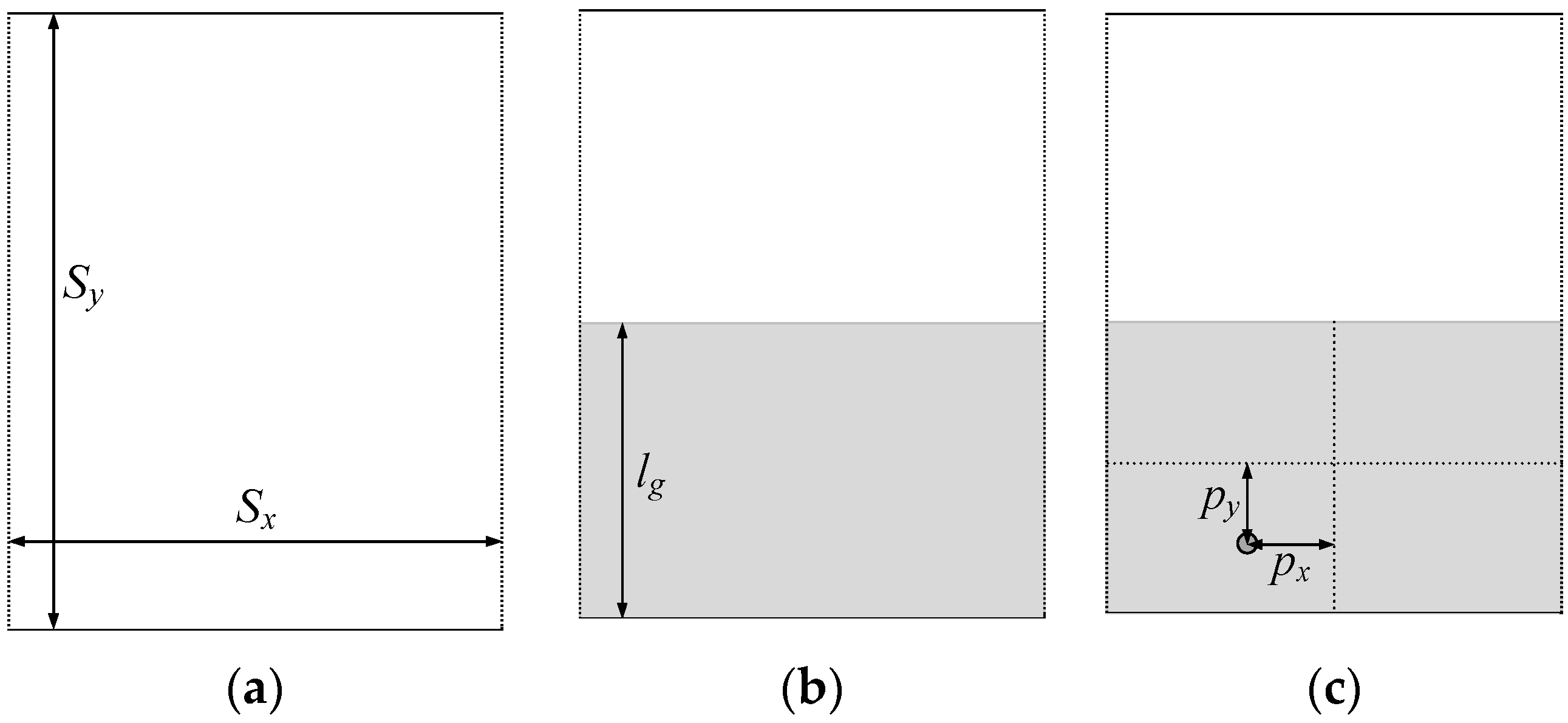

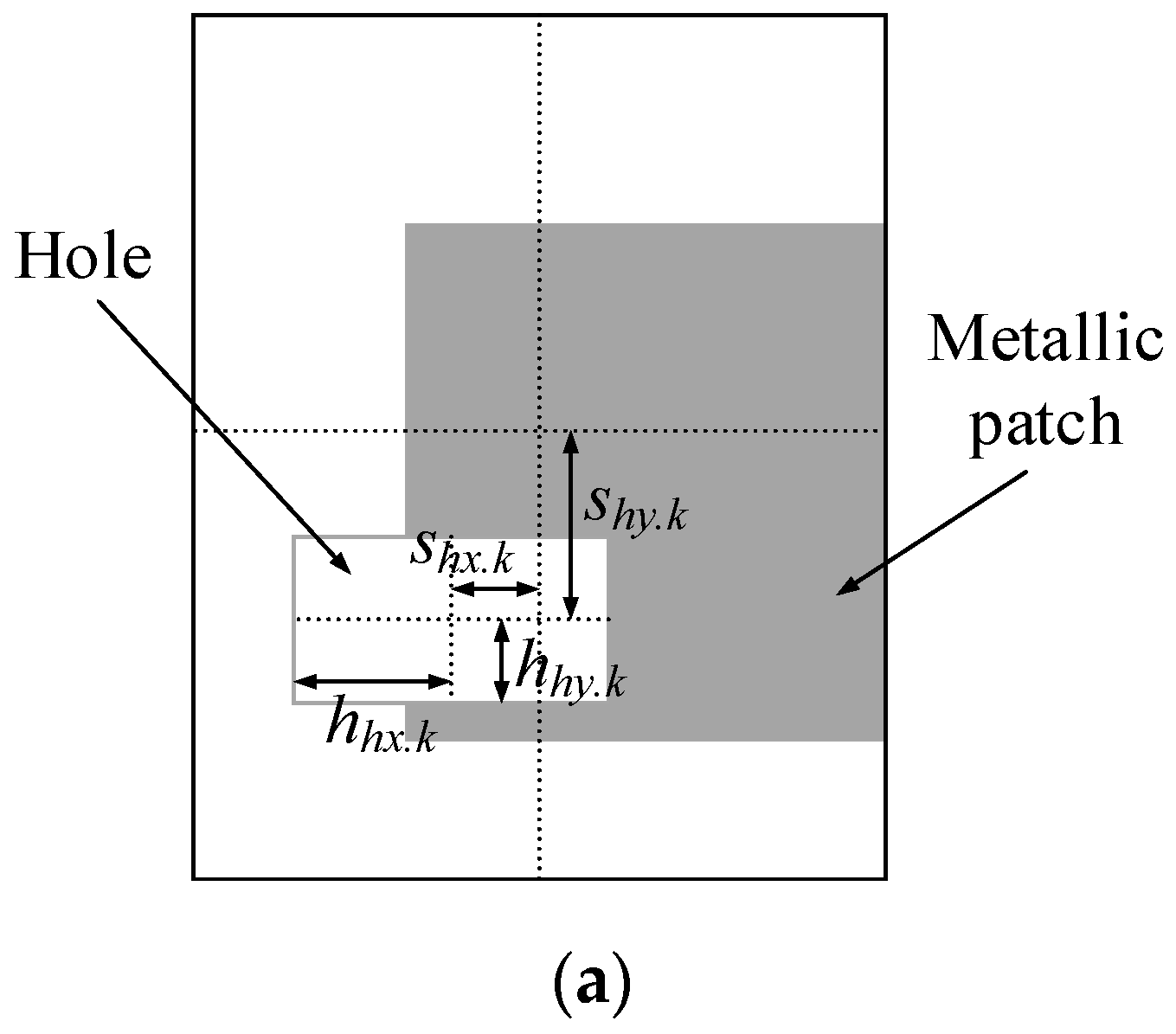




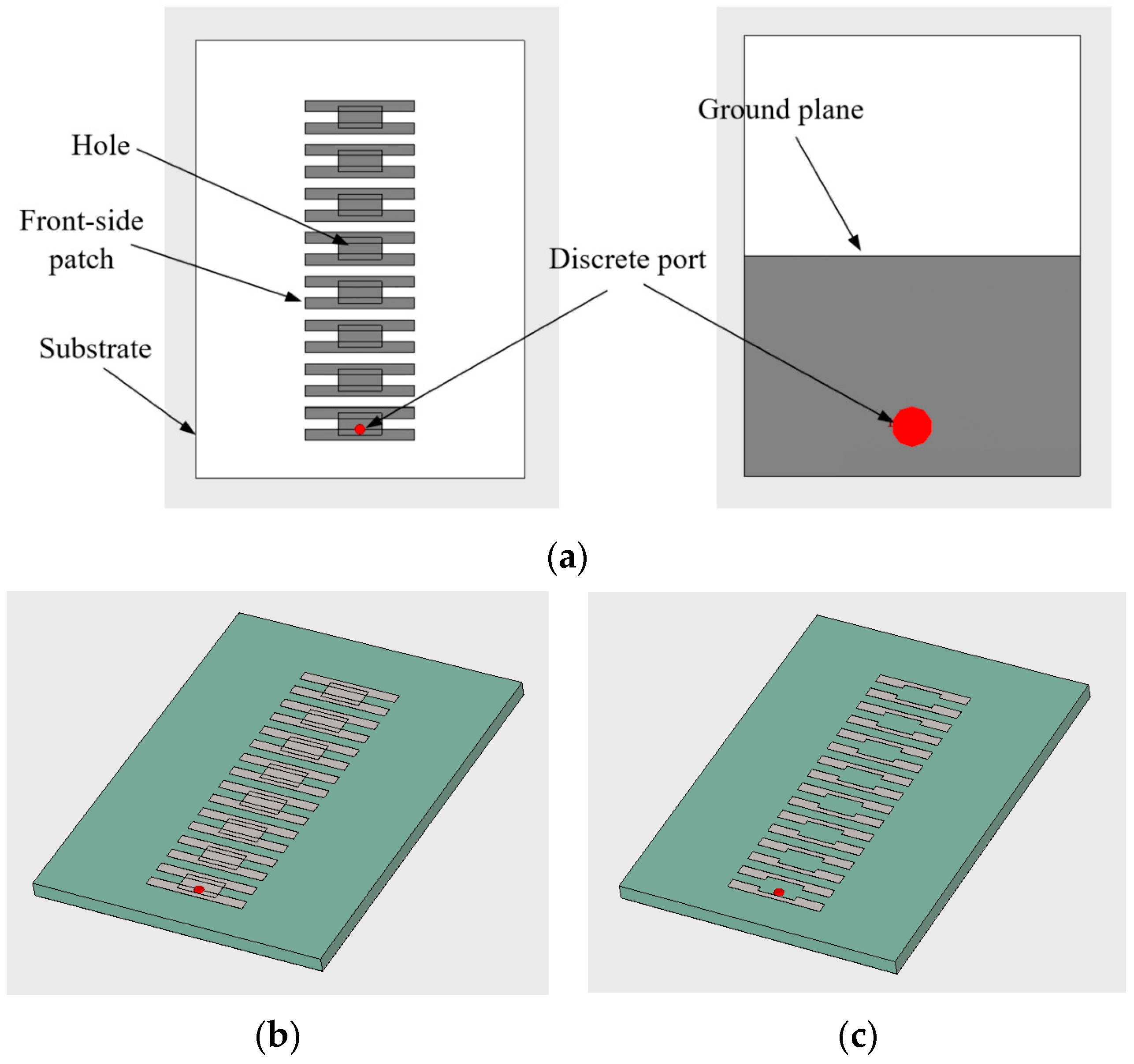
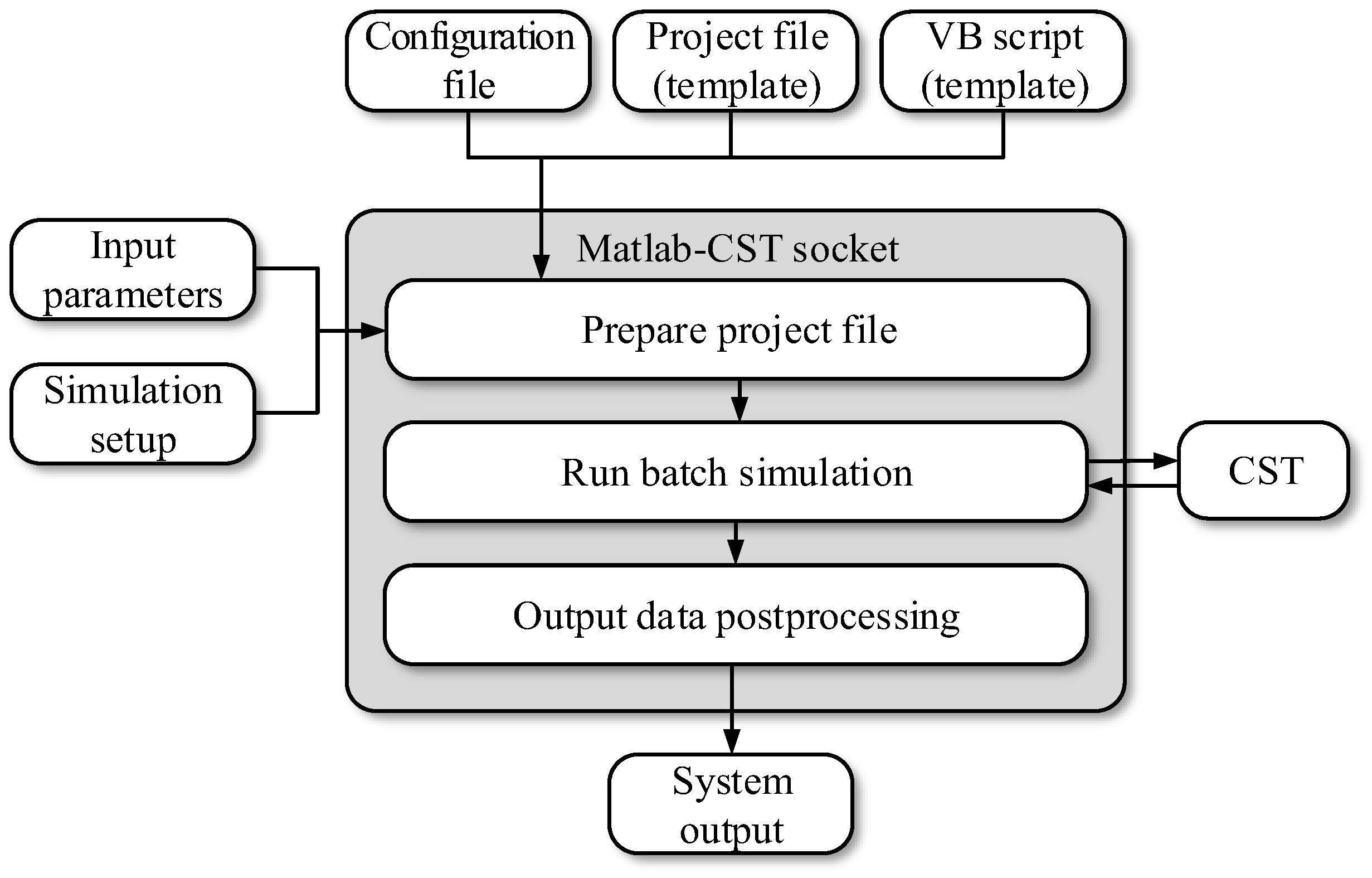



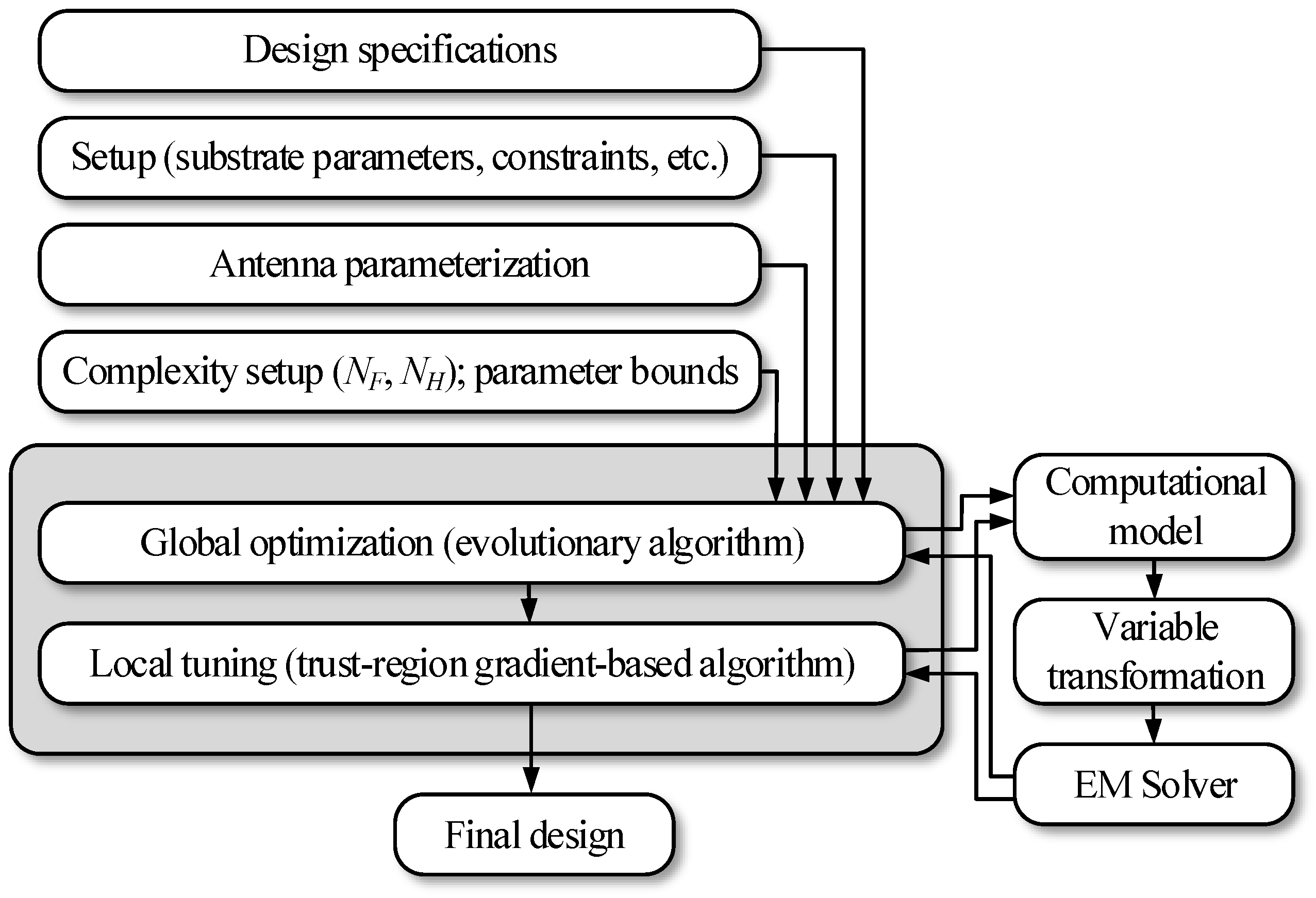
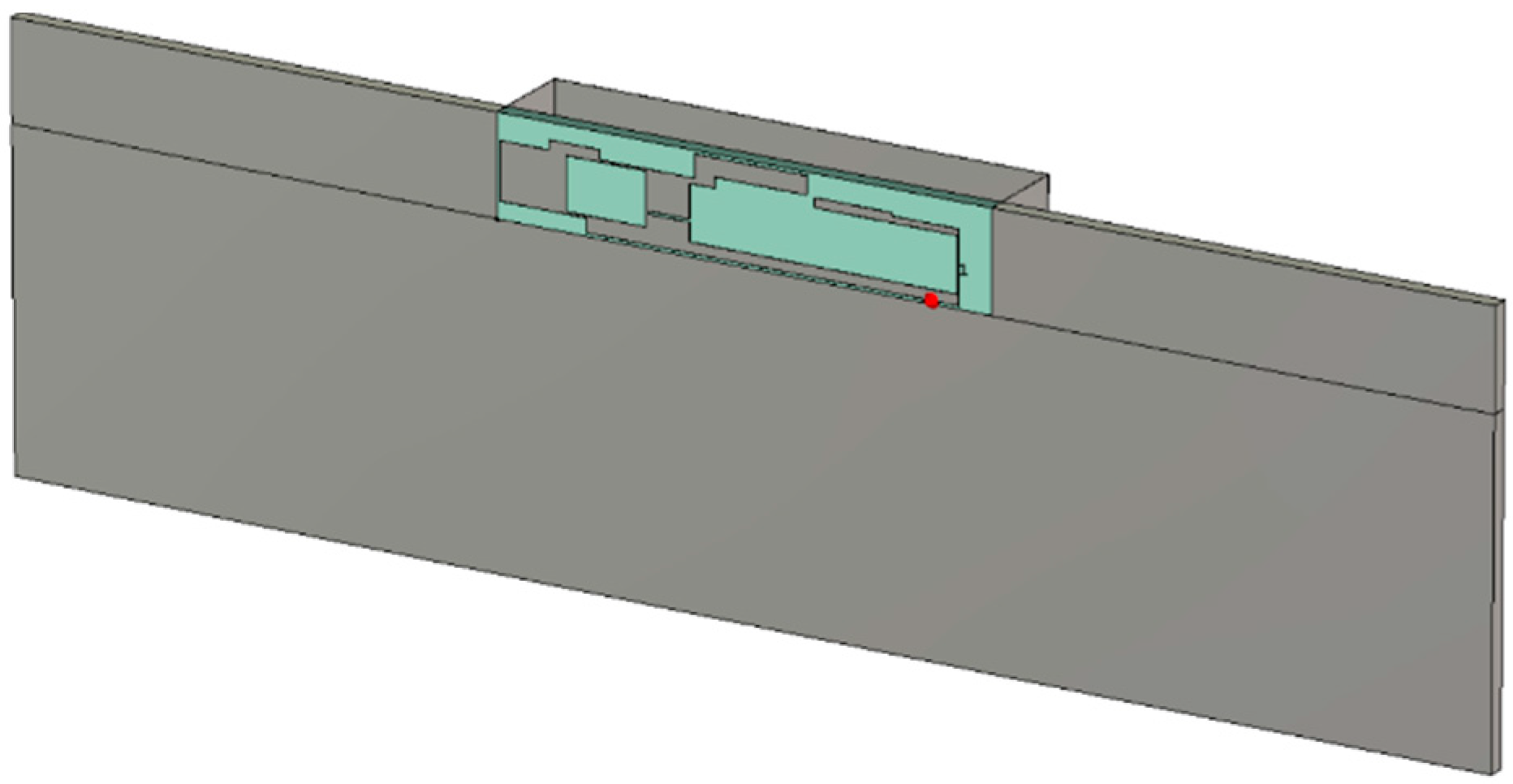

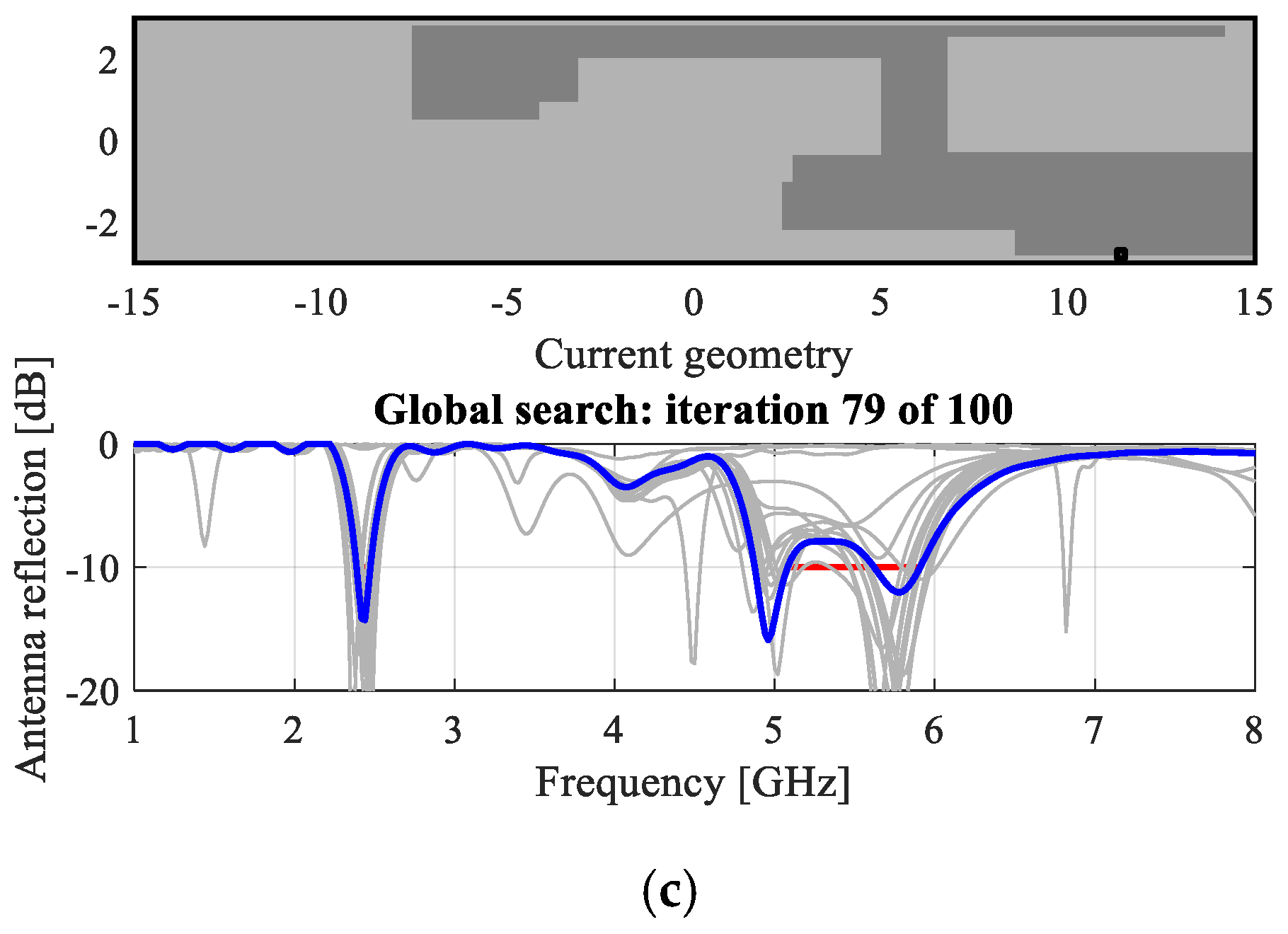

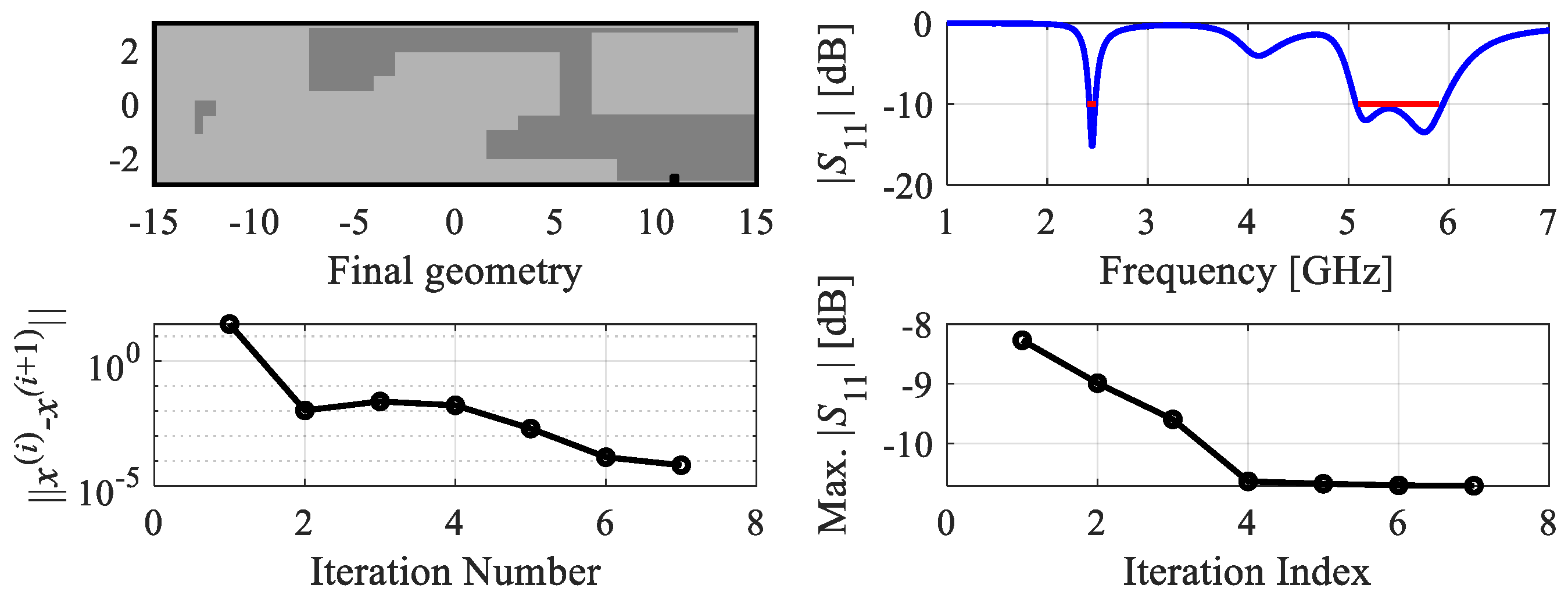

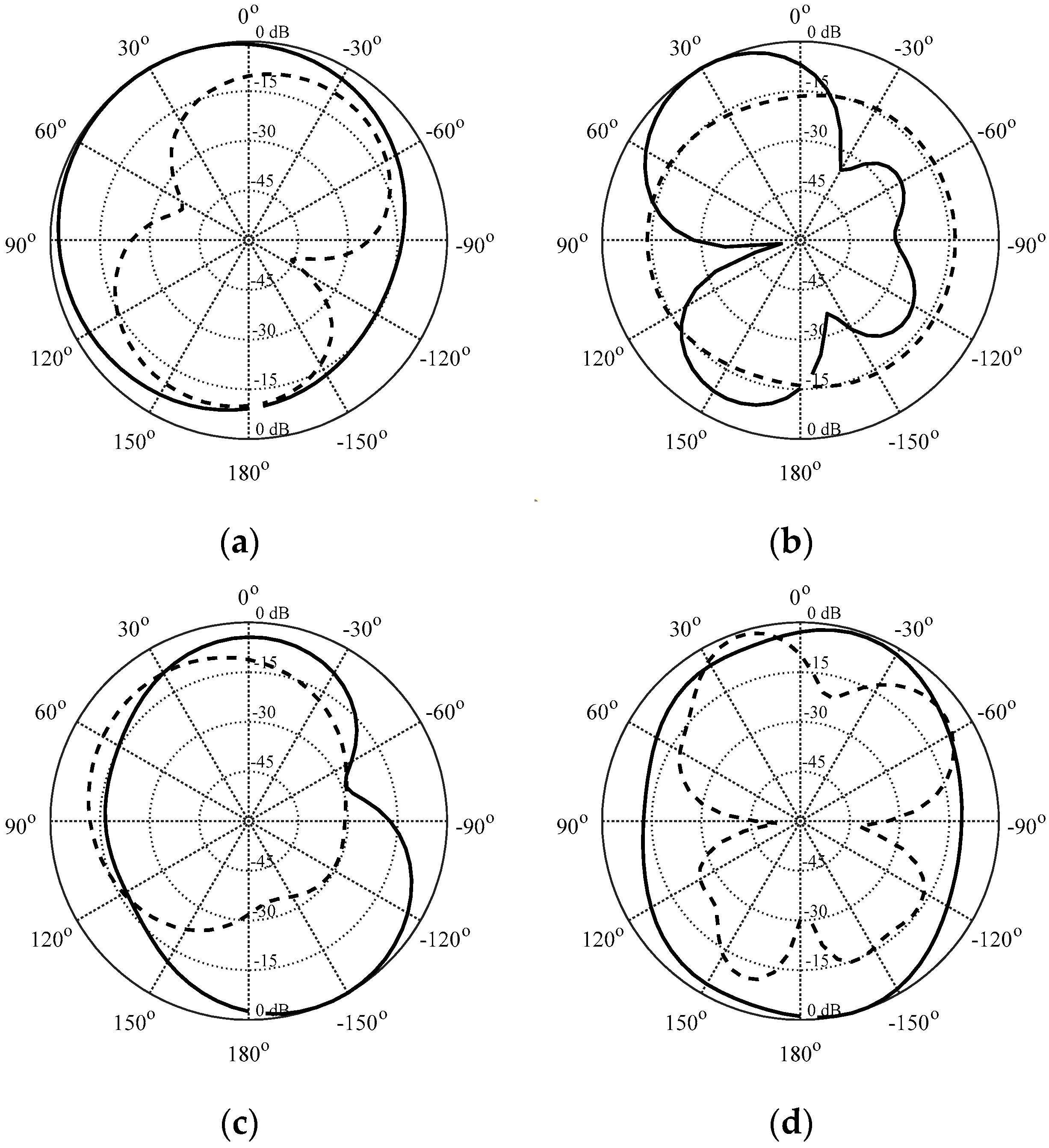
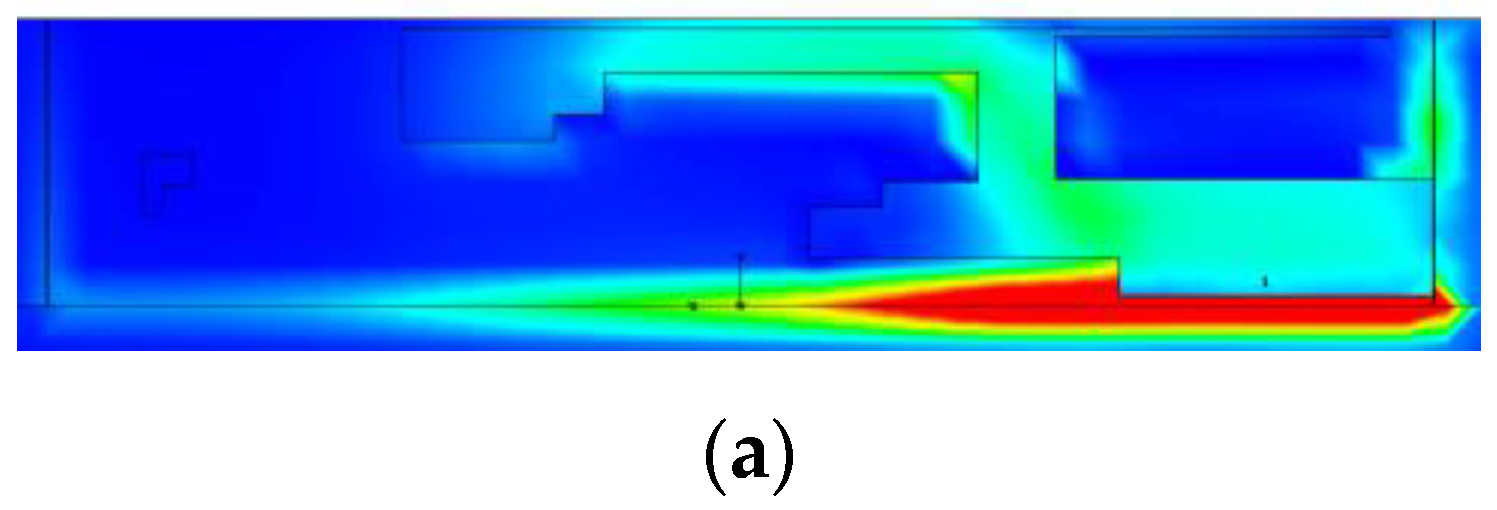

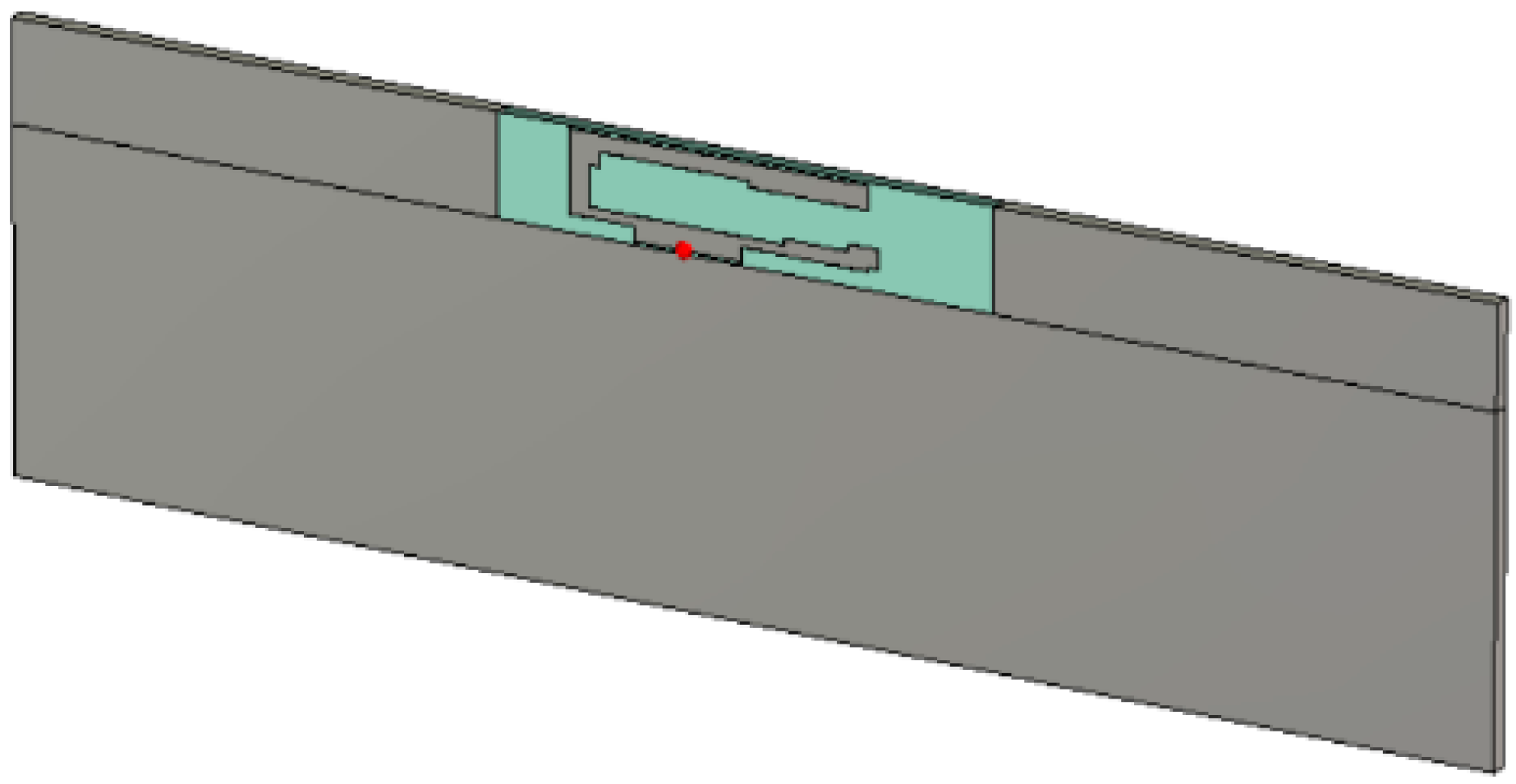
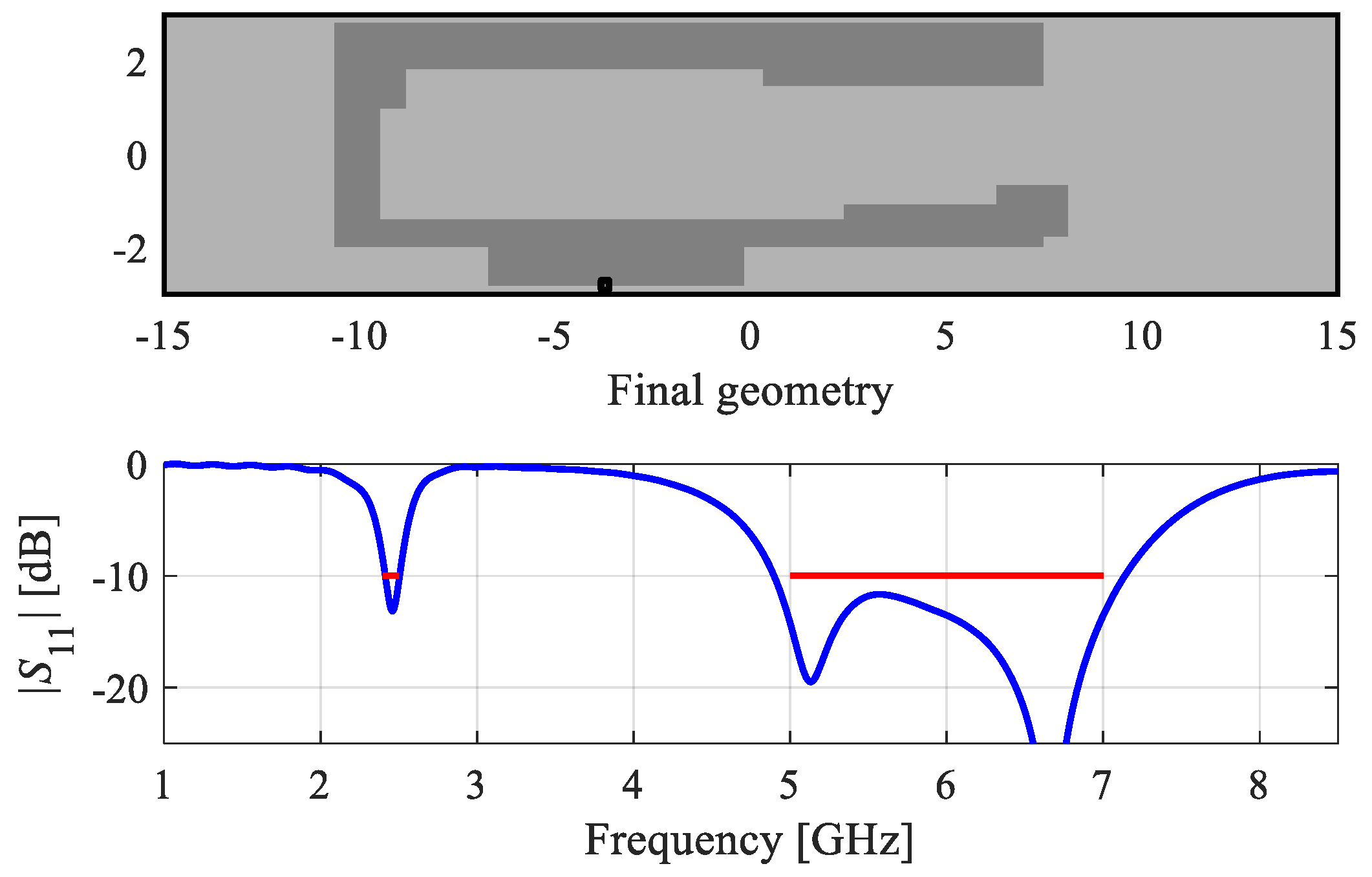

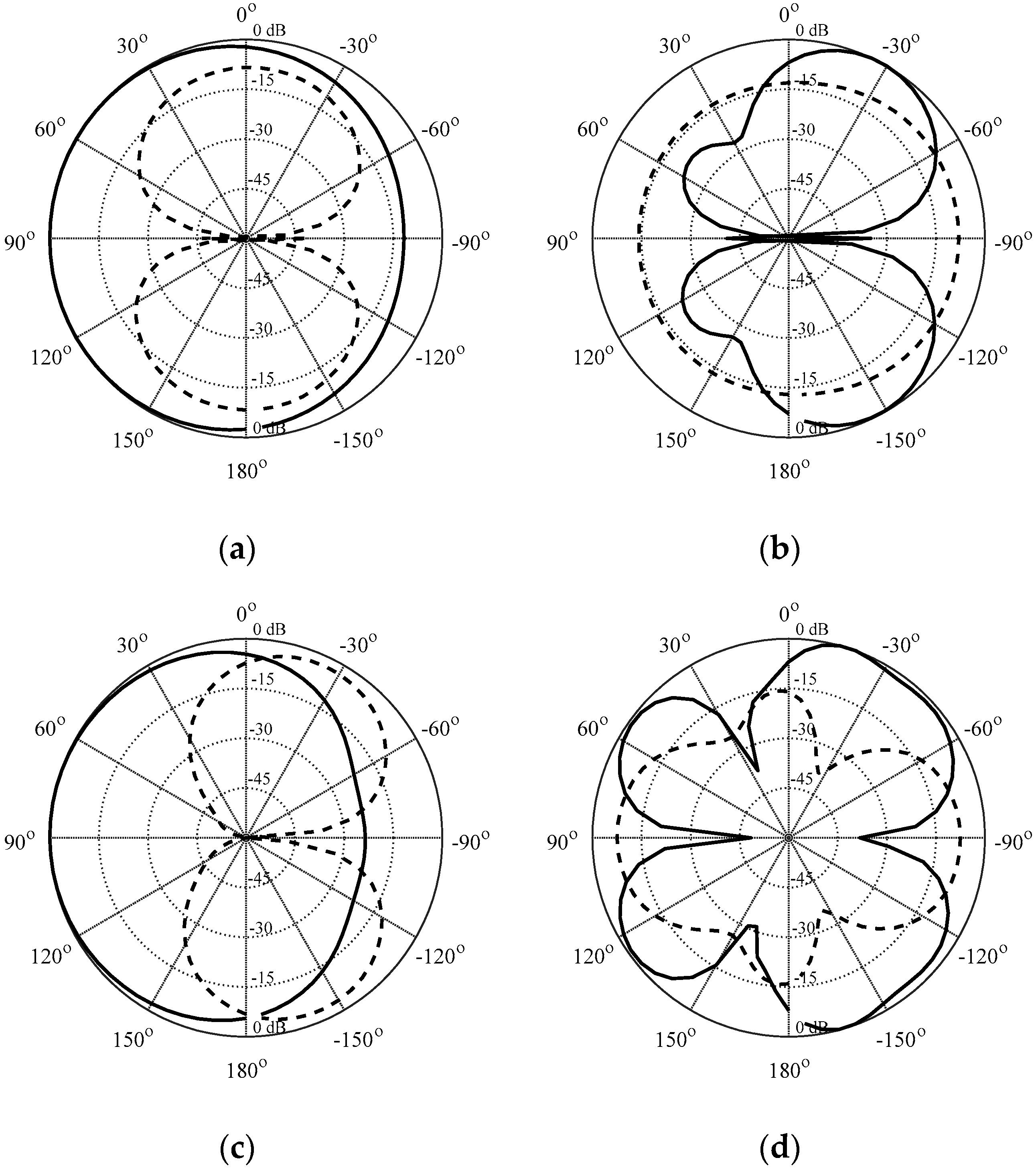

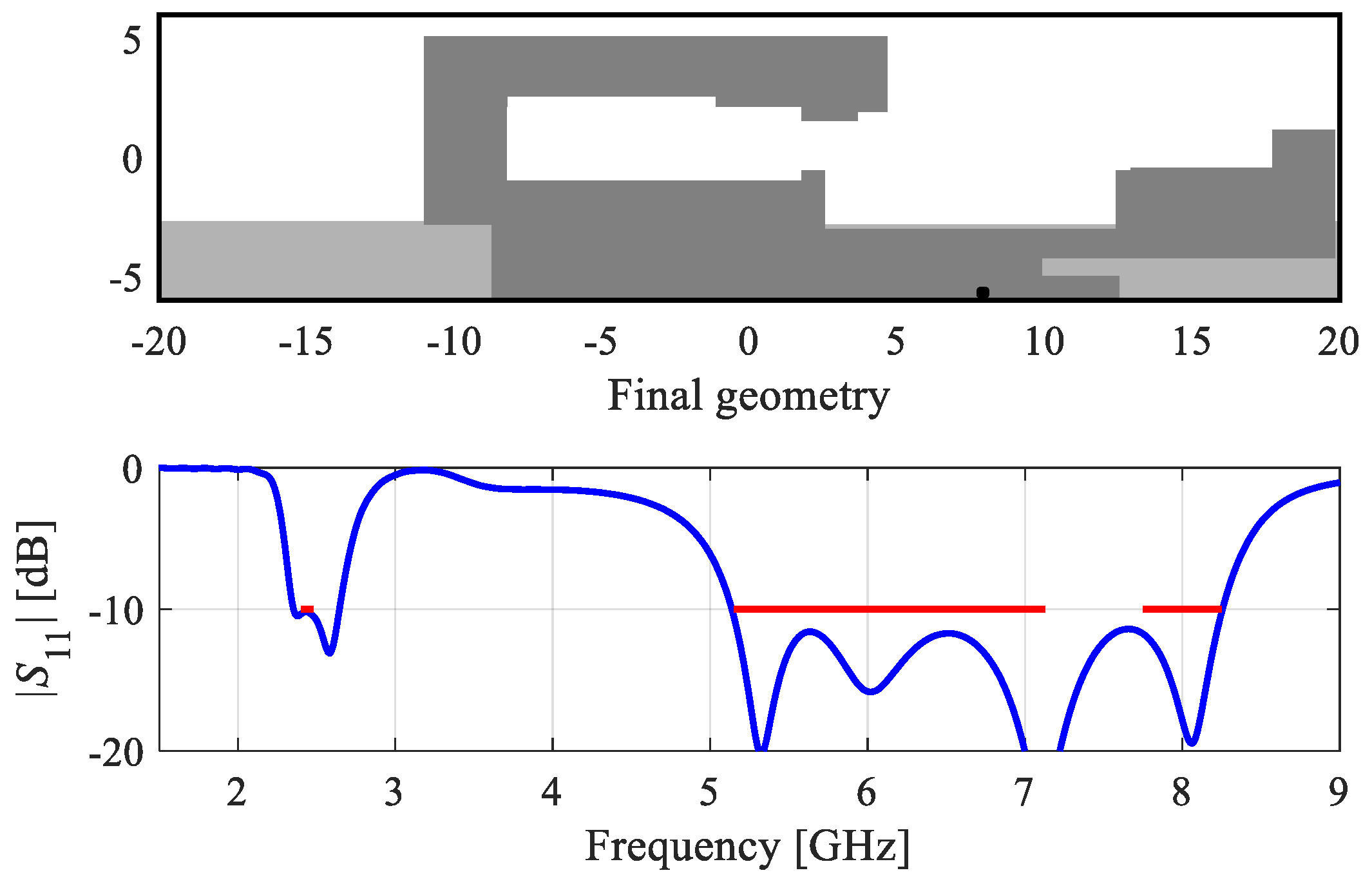
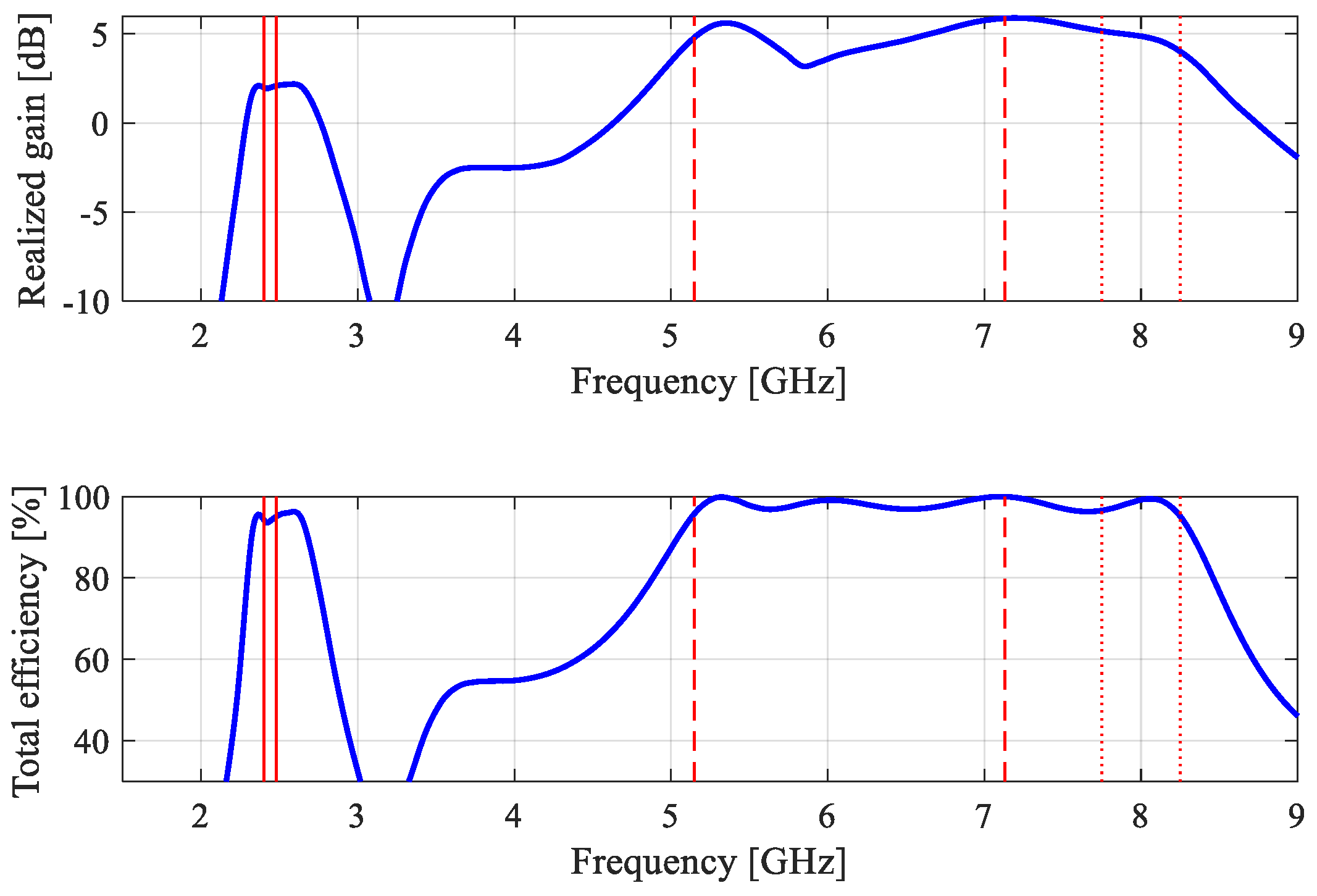
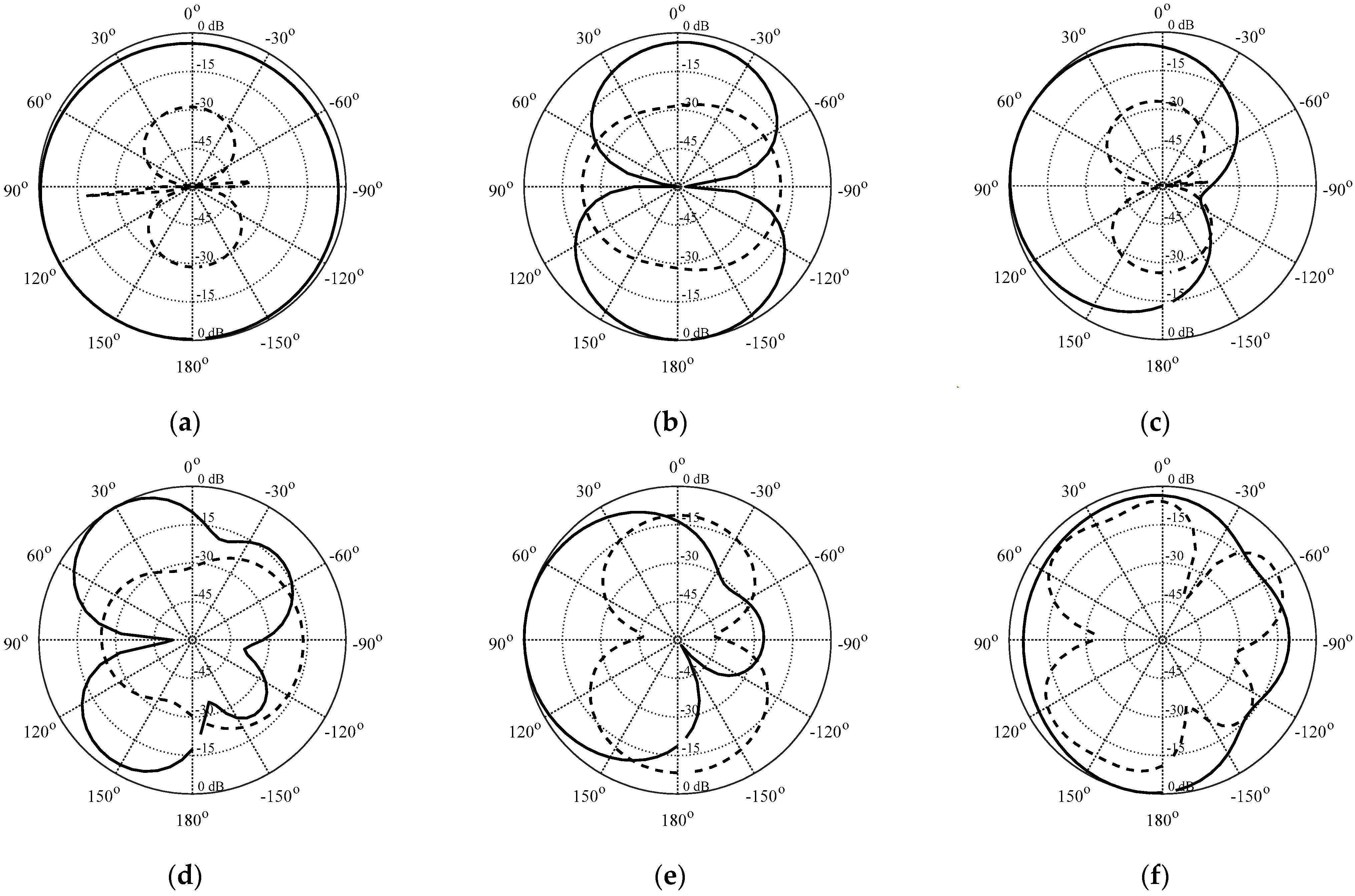
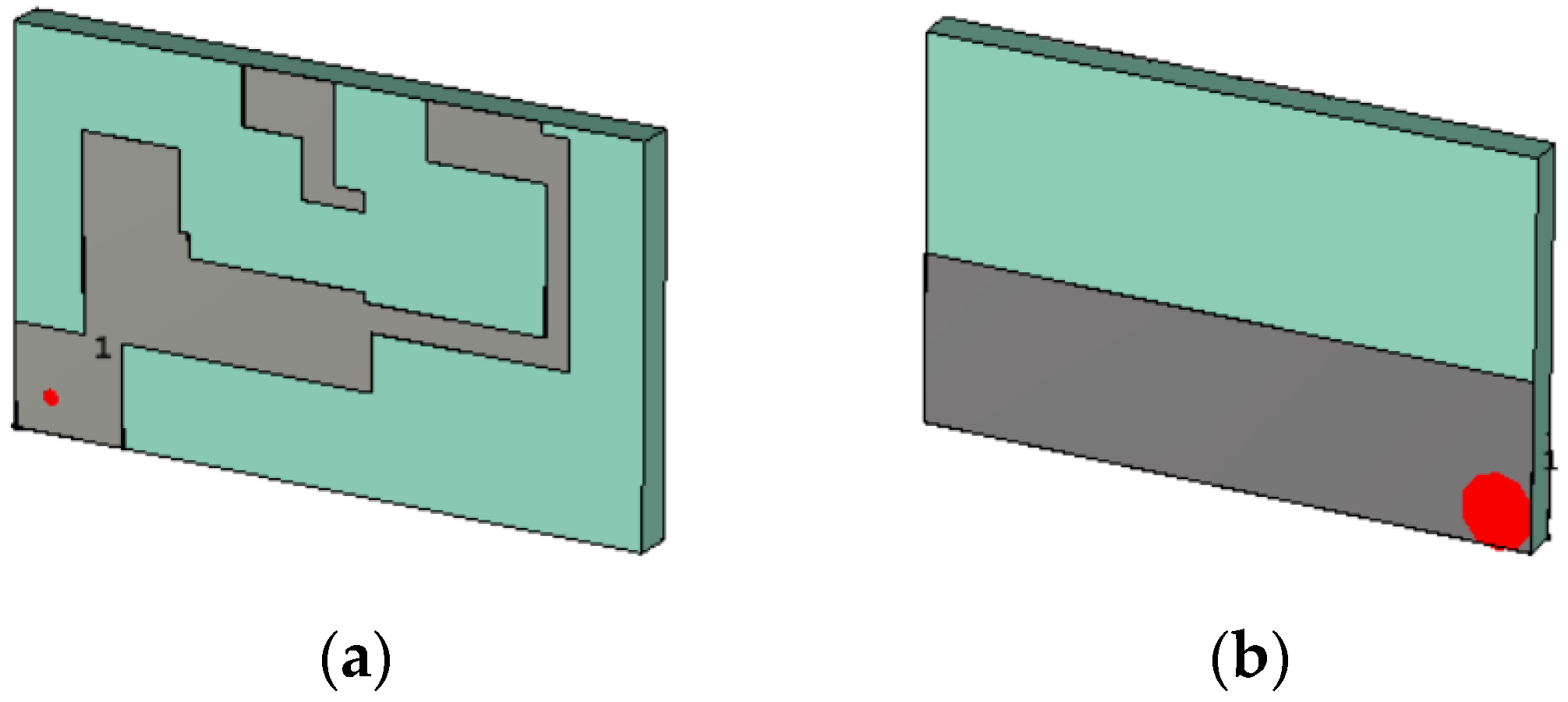




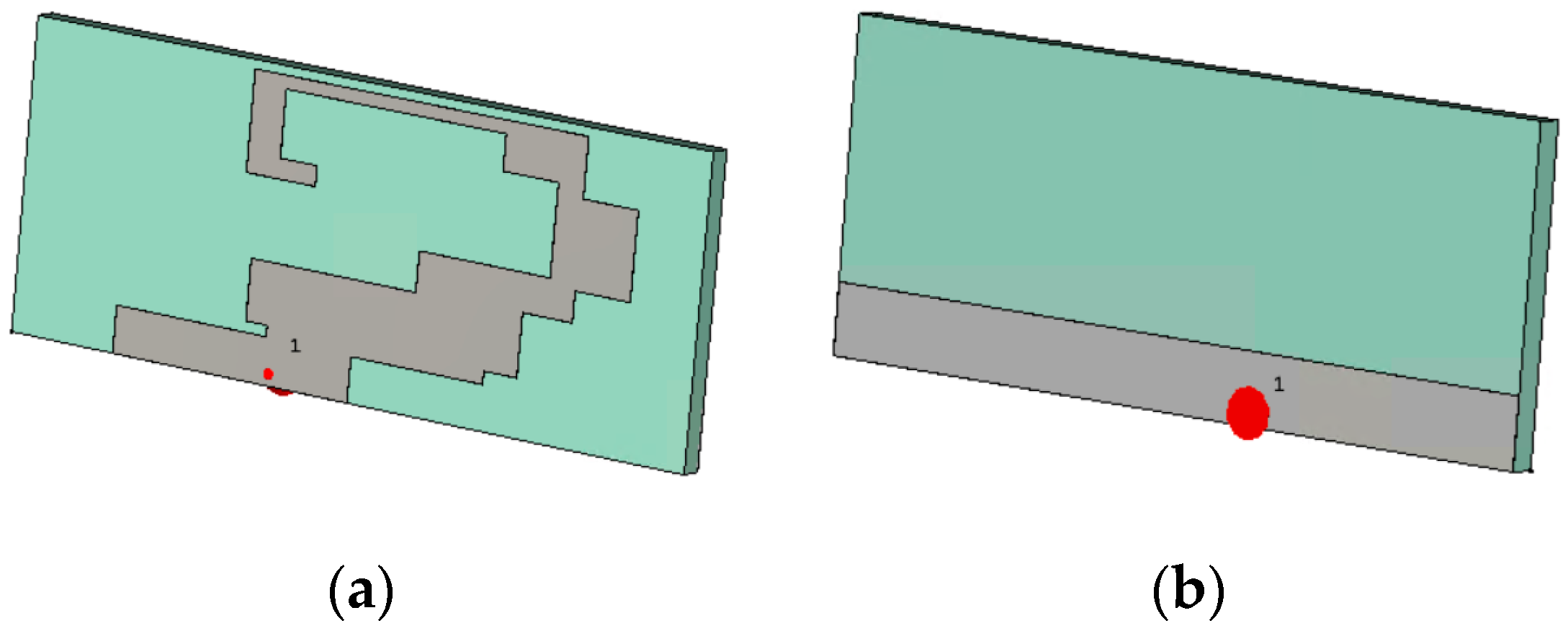


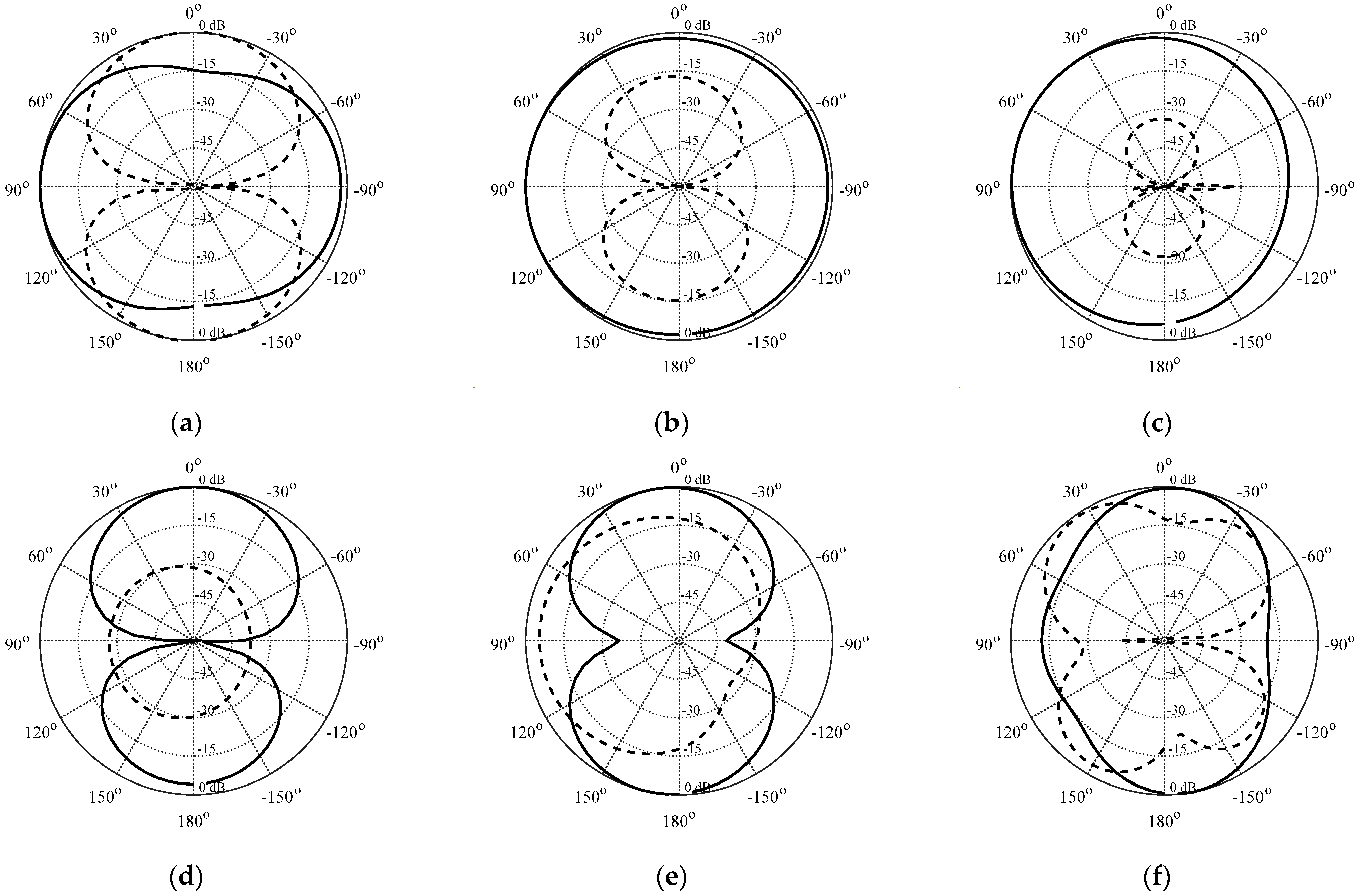

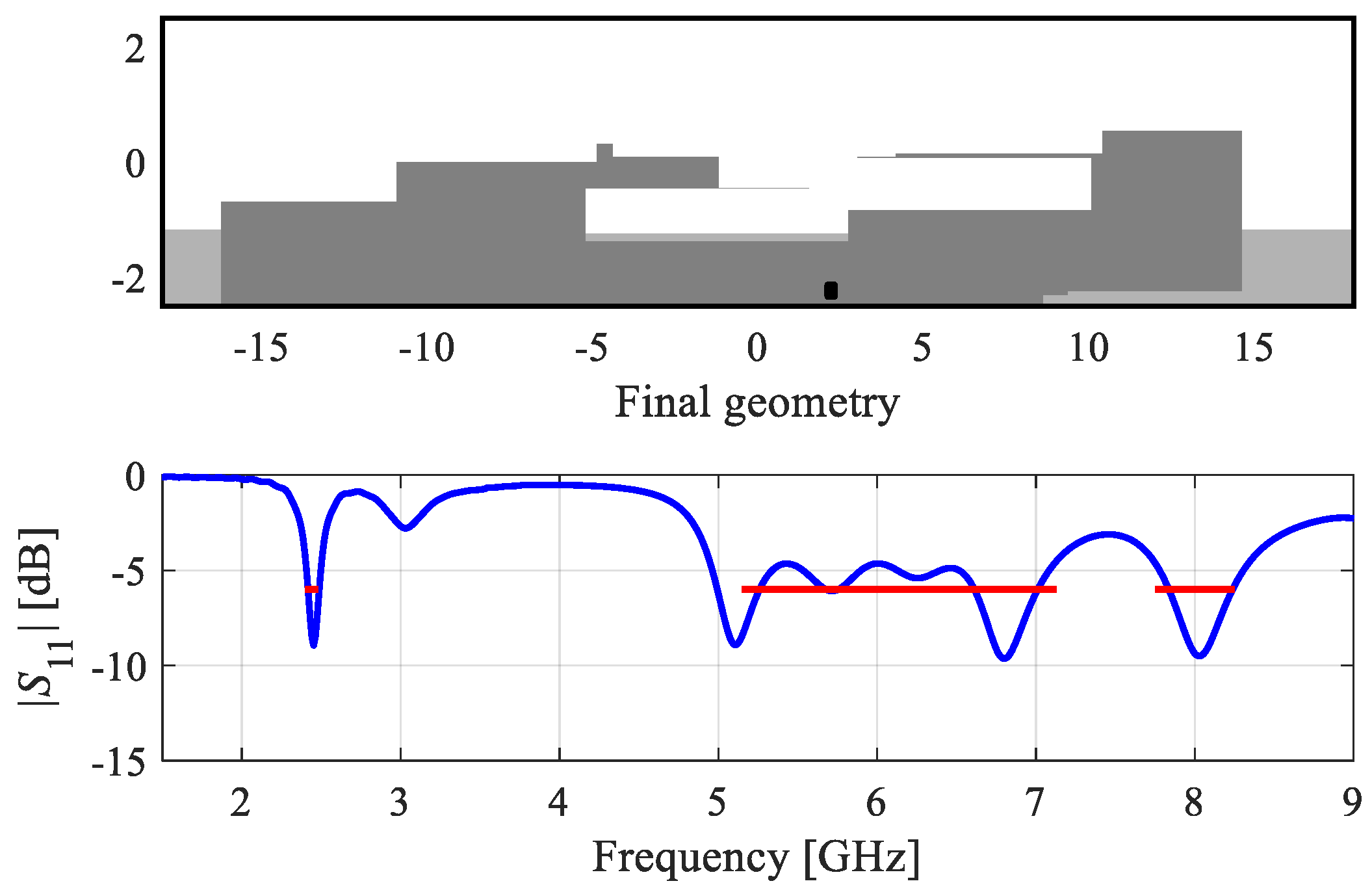
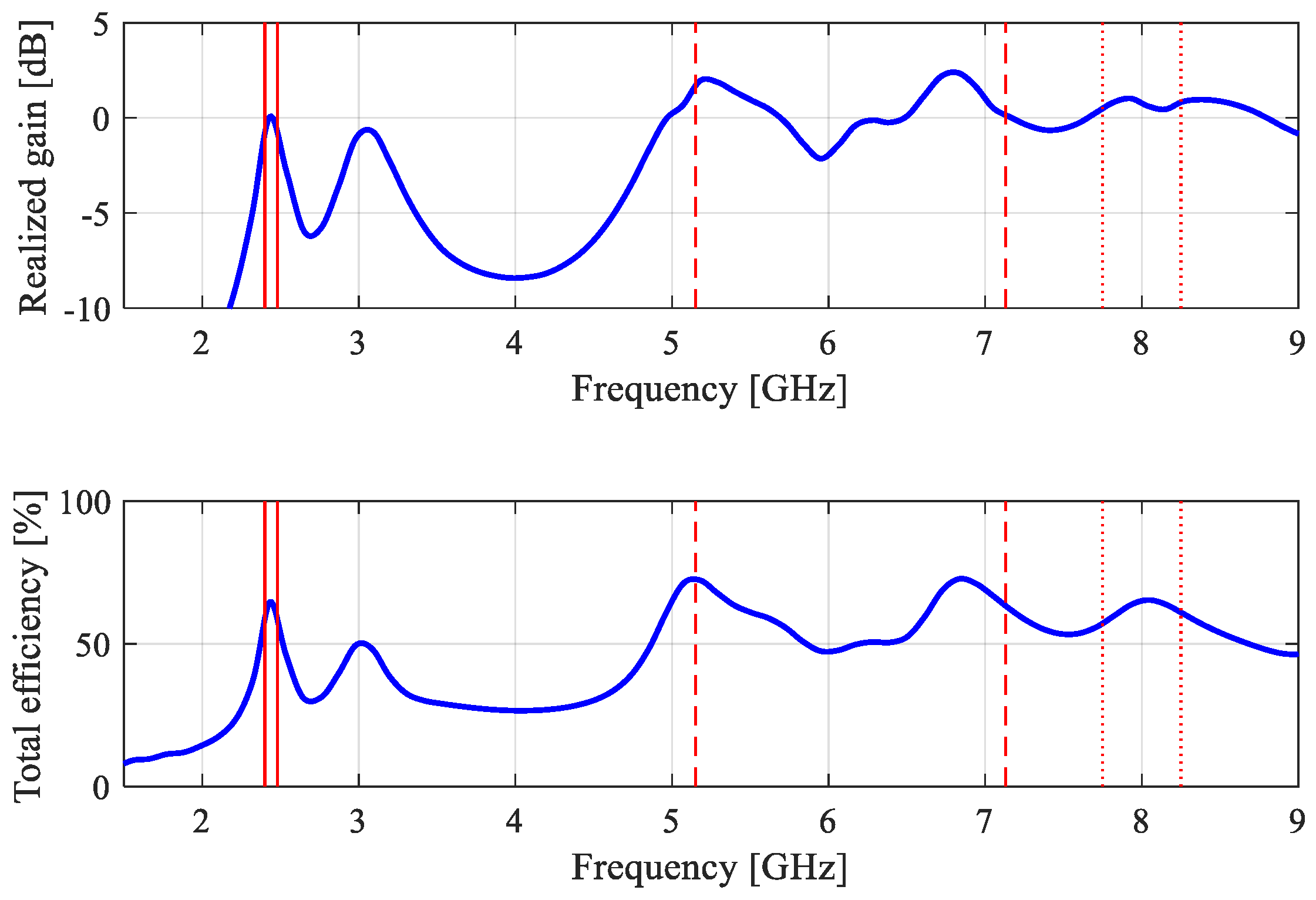

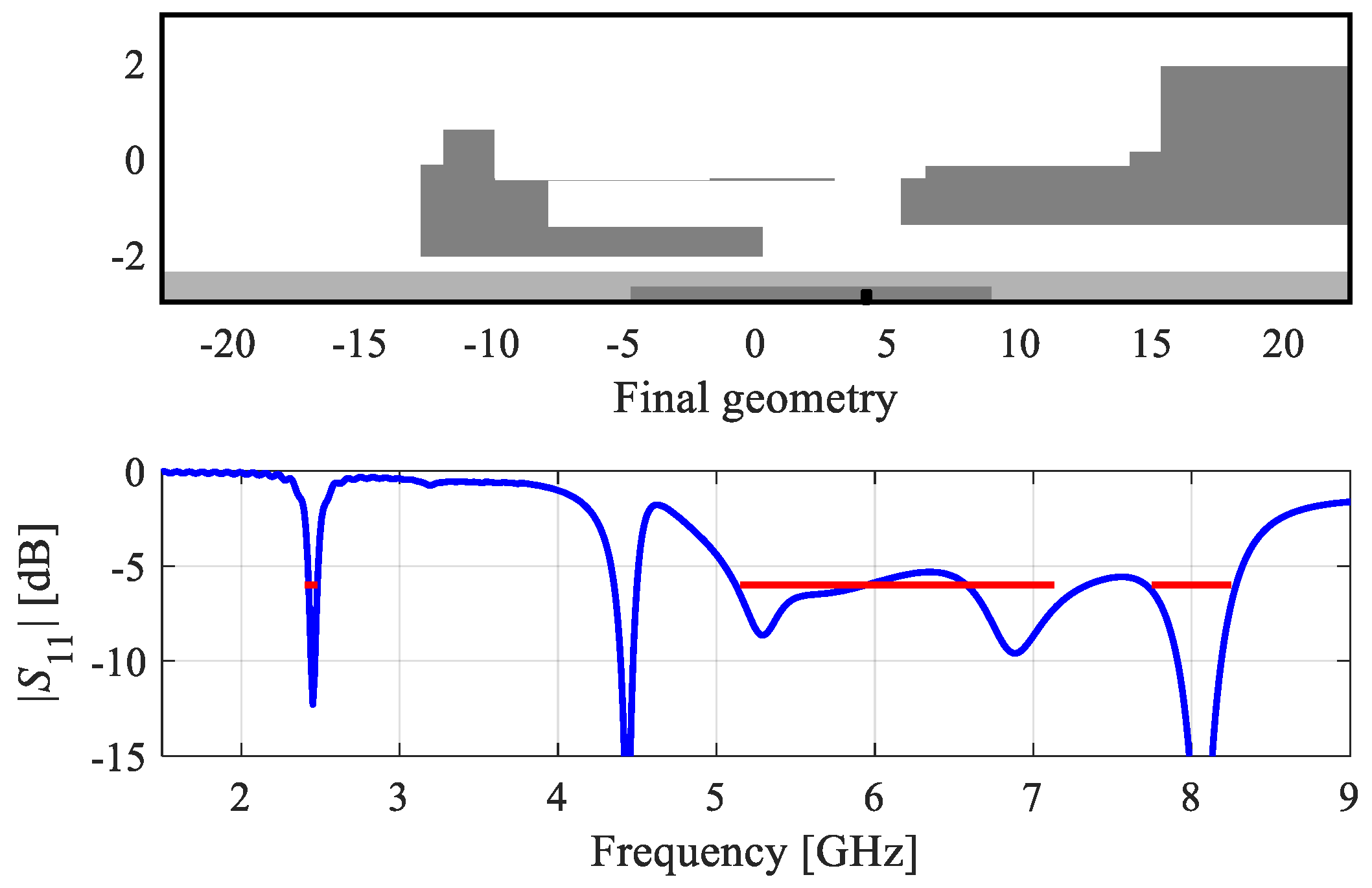

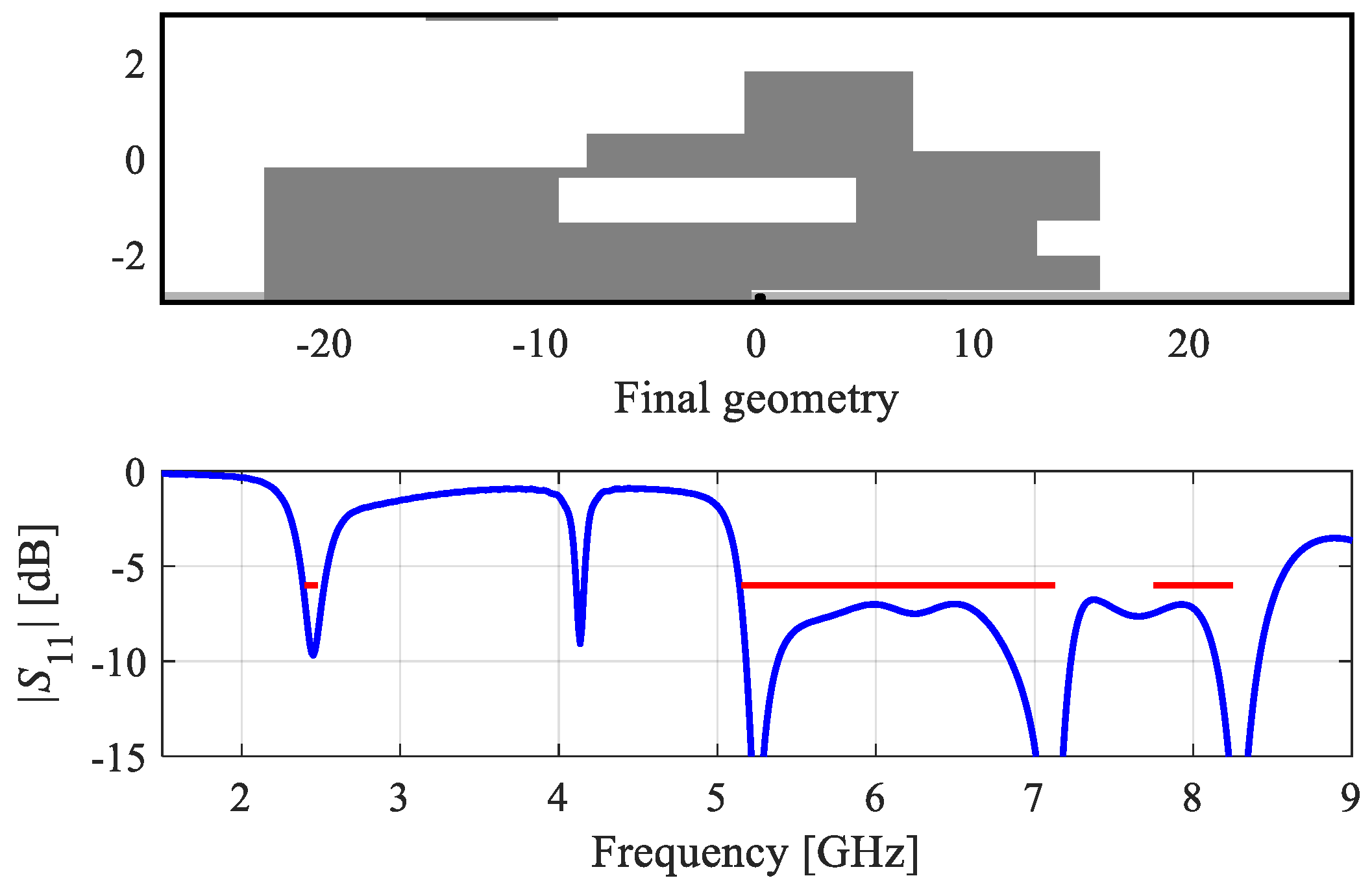

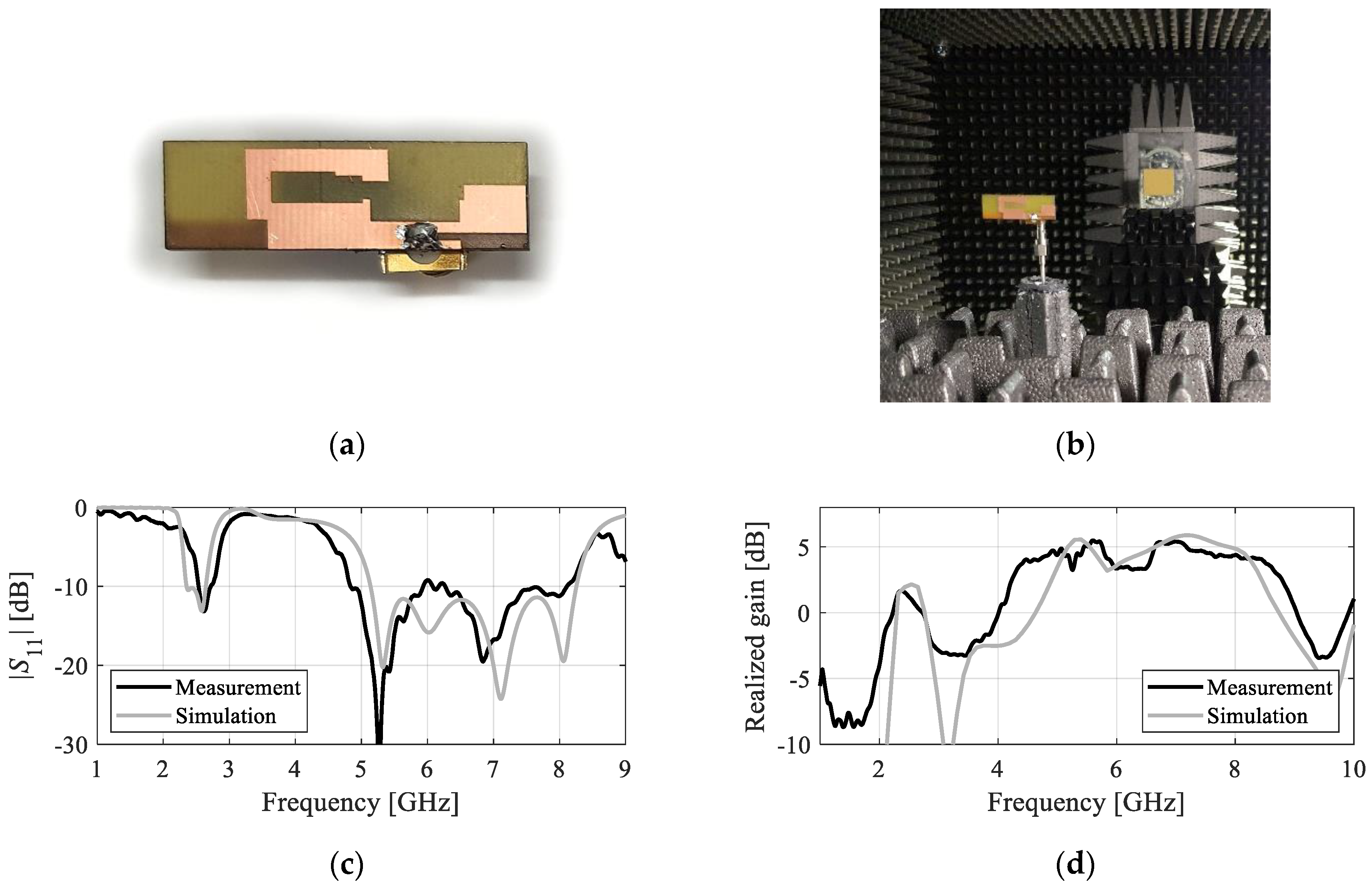



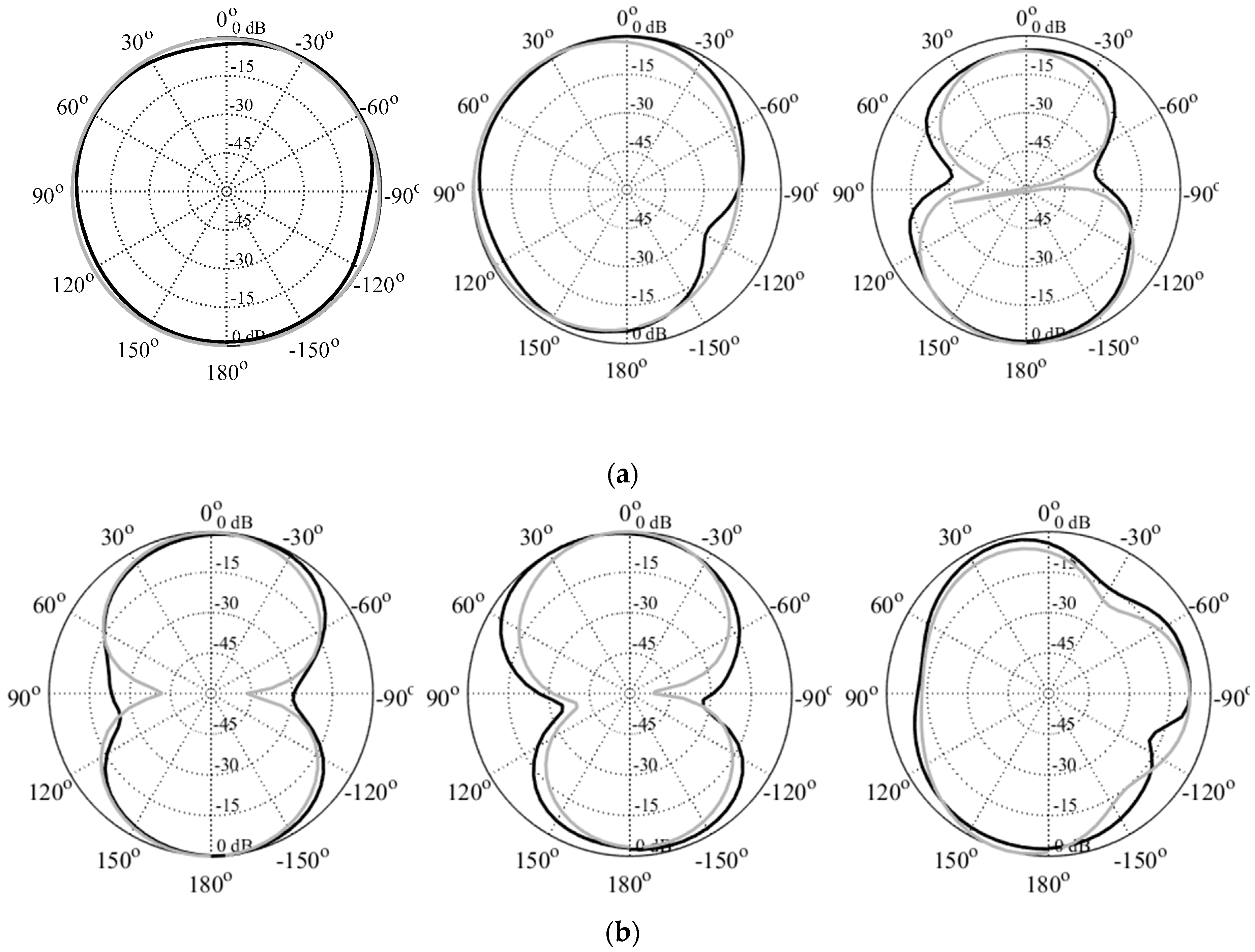
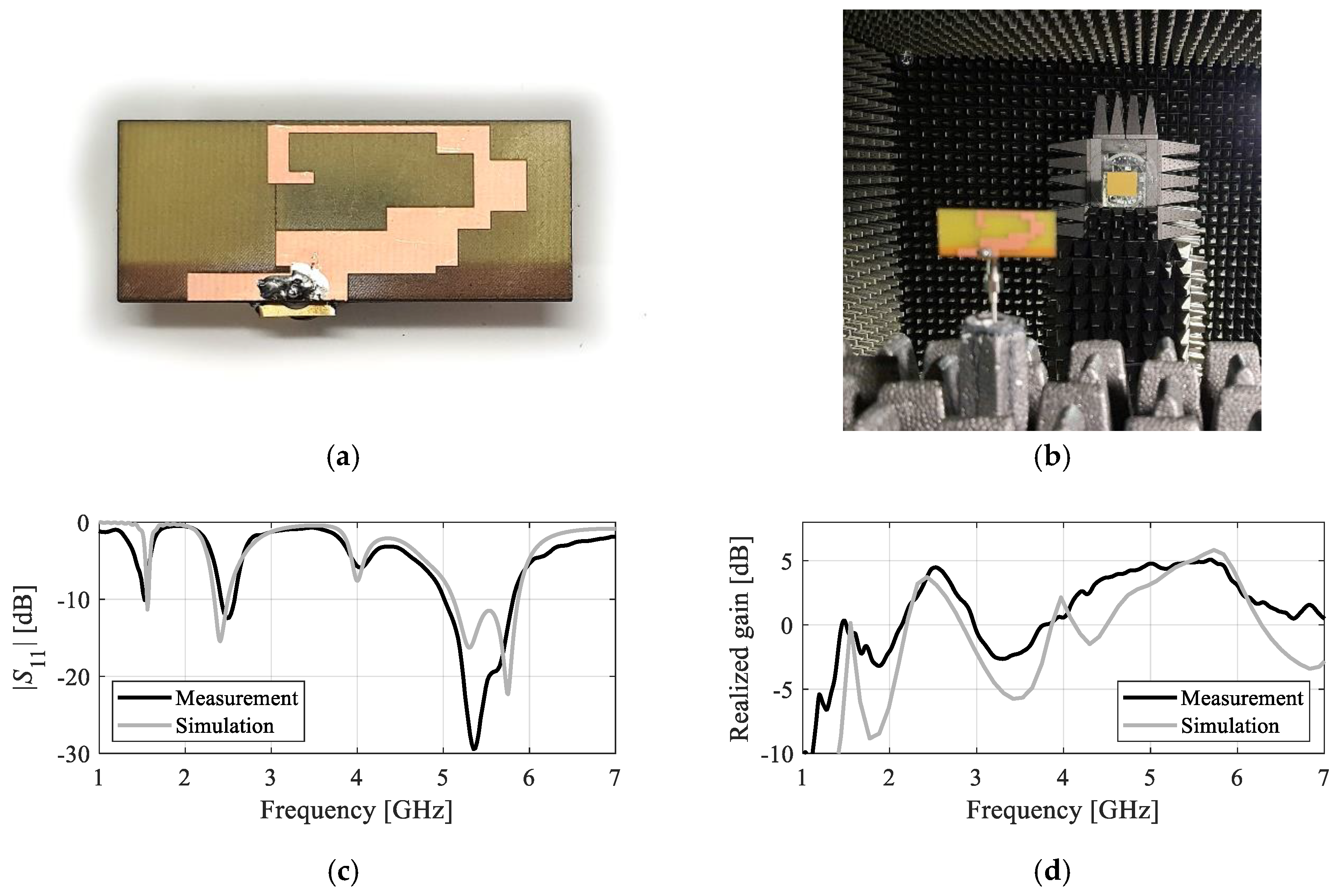

Disclaimer/Publisher’s Note: The statements, opinions and data contained in all publications are solely those of the individual author(s) and contributor(s) and not of MDPI and/or the editor(s). MDPI and/or the editor(s) disclaim responsibility for any injury to people or property resulting from any ideas, methods, instructions or products referred to in the content. |
© 2023 by the authors. Licensee MDPI, Basel, Switzerland. This article is an open access article distributed under the terms and conditions of the Creative Commons Attribution (CC BY) license (https://creativecommons.org/licenses/by/4.0/).
Share and Cite
Koziel, S.; Dou, W.; Renner, P.; Cohen, A.; Tian, Y.; Zhu, J.; Pietrenko-Dabrowska, A. On Unsupervised Artificial Intelligence-Assisted Design of Antennas for High-Performance Planar Devices. Electronics 2023, 12, 3462. https://doi.org/10.3390/electronics12163462
Koziel S, Dou W, Renner P, Cohen A, Tian Y, Zhu J, Pietrenko-Dabrowska A. On Unsupervised Artificial Intelligence-Assisted Design of Antennas for High-Performance Planar Devices. Electronics. 2023; 12(16):3462. https://doi.org/10.3390/electronics12163462
Chicago/Turabian StyleKoziel, Slawomir, Weiping Dou, Peter Renner, Andrew Cohen, Yuandong Tian, Jiang Zhu, and Anna Pietrenko-Dabrowska. 2023. "On Unsupervised Artificial Intelligence-Assisted Design of Antennas for High-Performance Planar Devices" Electronics 12, no. 16: 3462. https://doi.org/10.3390/electronics12163462
APA StyleKoziel, S., Dou, W., Renner, P., Cohen, A., Tian, Y., Zhu, J., & Pietrenko-Dabrowska, A. (2023). On Unsupervised Artificial Intelligence-Assisted Design of Antennas for High-Performance Planar Devices. Electronics, 12(16), 3462. https://doi.org/10.3390/electronics12163462







